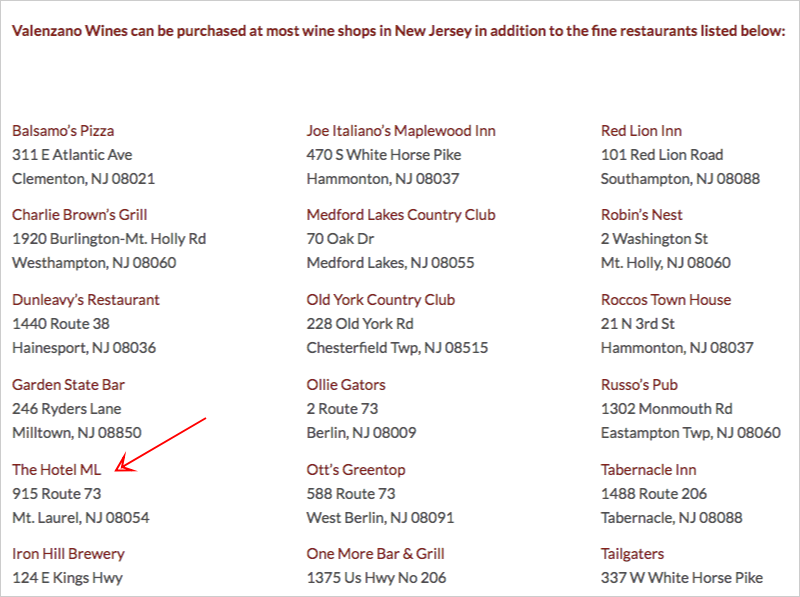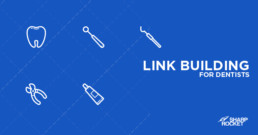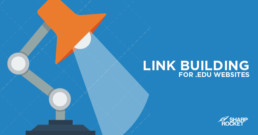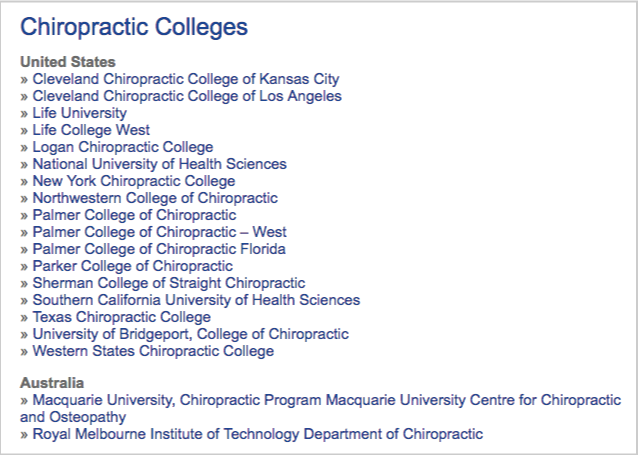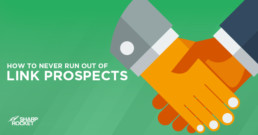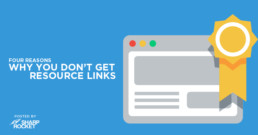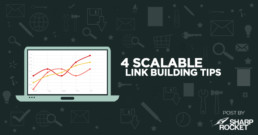Link Building for Hotels
So far, we have published six link building guides that will help you unlock potential link building ideas for your campaigns. If you haven't seen them yet, you can check out the following links:
- Link Building for Real Estate
- Link Building for Lawyers
- Link Building for Drug Rehab Centers
- Link Building for Fashion
- Link Building for Dentists
- Link Building for .EDU Websites
Today, we'll cover another industry that demands ideas for link building - the hotel industry.
This link building guide is mostly applicable for brands looking to get more visibility on search by properly acquiring links for their hotel SEO campaigns.

Continue reading:
Table of Contents
NEARBY OR AREA HOTEL PAGES
If there's one hotel link building technique that doesn't require content to be published in order to get links from other sites, it is, leveraging nearby hotels or area hotels resource pages.
Here's an example of that. As you can see in the image below, it's a resource page that lists down hotels within the location - helping visitors get the exact information of nearby hotels from the page, including the address and their booking contact details.
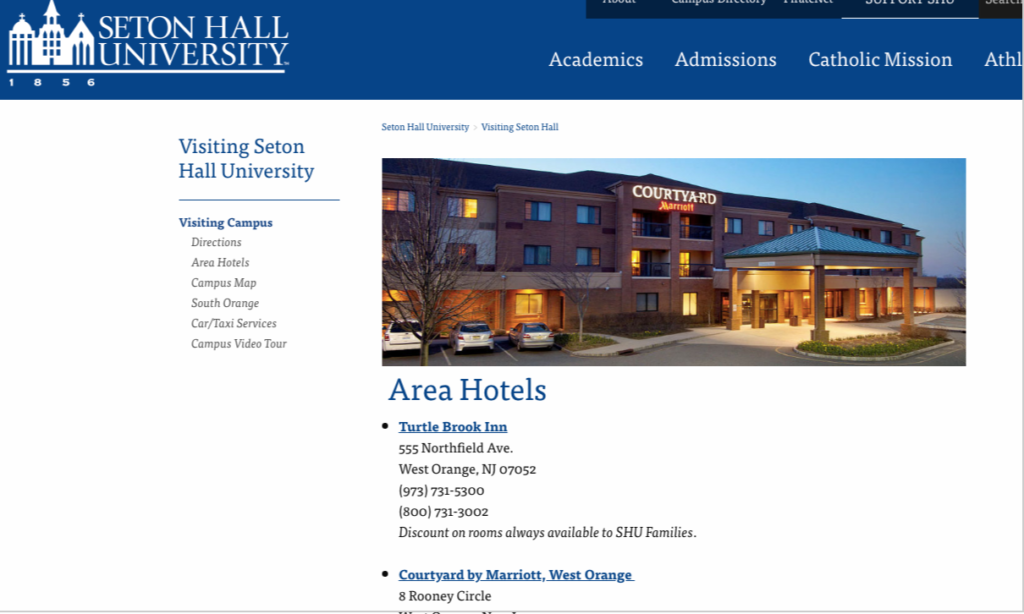
Whether you're in New Jersey, Florida or other cities in the U.S. or in other countries, there are available nearby hotels links pages.
You can do a Google search using any of the following queries to find those link type opportunities:
- site:.edu "nearby hotels" [location]
- "nearby hotels" [location]
- "area hotels" [location]
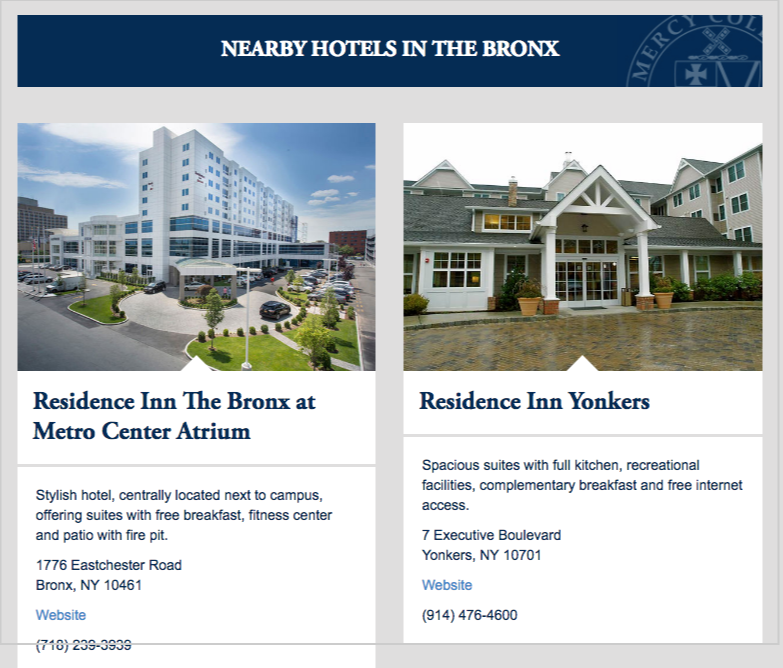
If offering discounts for customers is part of your marketing campaigns, you can couple your outreach with a customized discount code or any other offerings to get increase the likelihood of getting links from your outreach targets.
PRODUCTS YOU SELL
In your hotels, you normally have restaurants and bar sections or lounges where you sell popular products such as beers or wines.
You may create a list of all of these products or get a product inventory from your hotel brand. Research and see if manufacturers or sellers of your products have their own websites.
You'll find that they have pages dedicated to how to purchase or finding their [product]. These pages include external links or sources of exact stores where products can be bought.
Curators or webmasters of "how to purchase [product ] pages are receptive to outreach of direct partners/retailers, given it's an added value for their visitors looking for specific products.
Find Our Product [Location]
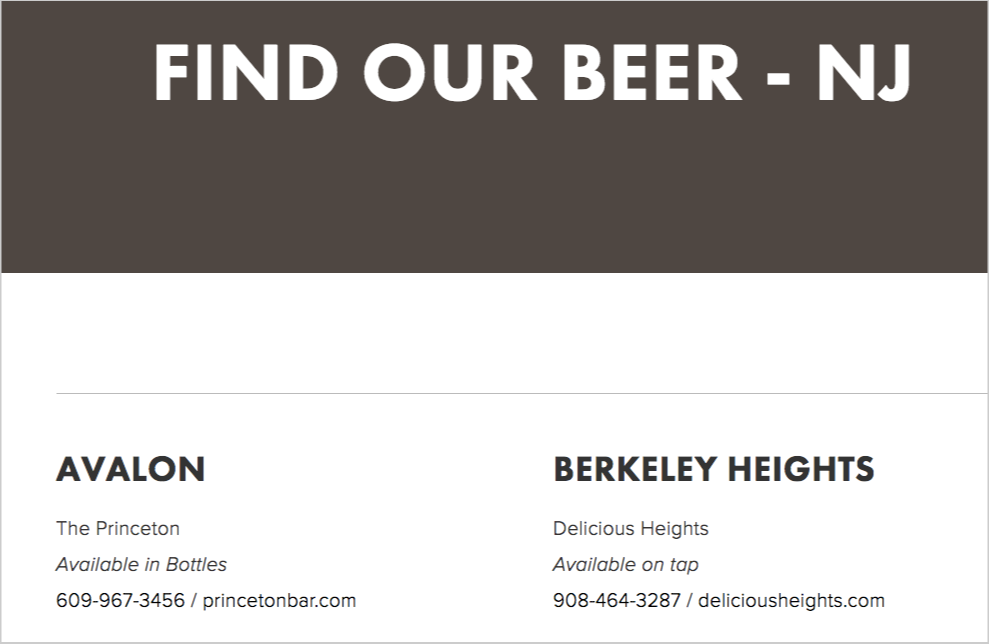
You may use any of these Google search queries to find available how to purchase or find our product pages.
- "how to purchase [product]"
- "find our [product]" [location]
This link building strategy is a low-hanging fruit in acquiring links directly to your bar/restaurant page or to your homepage.
HOTEL DISCOUNTS FOR ALUMNI
Earlier, we discussed giving discounts to nearby hotels page curators. Now let's look at another type of hotel discounts.
If you're doing link building for hotels, it is best to come up with a specific campaign that offers discounts for alumni of universities. There are a handful opportunities of this link type that you can leverage to get not just links, but assisted conversions from visitors clicking your links.
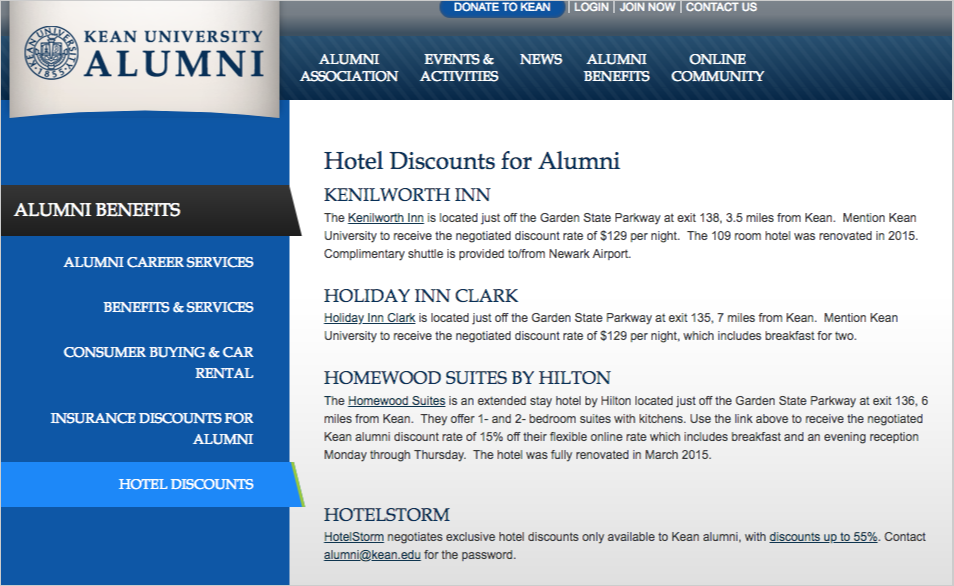
For link prospecting sake, here are useful search queries that will benefit you in finding hundreds of hotel discounts pages (lesser number if you're too specific with your location query):
- site:.edu intitle:"hotel discounts"
- site:.edu "hotel discounts"
- site:.edu "hotel discounts" [location]
You may also localize your link search by targeting hotel alumni discount pages from universities and colleges within your region (check the third Google search query above).
HOTELS AND ACCOMMODATIONS PAGES
Aside from hotel discounts, universities, and colleges also have specific pages just for accommodations.
The page is dedicated for families, friends and guests of students looking for nearby accommodations either for regular or for occasions (e.g. graduation).
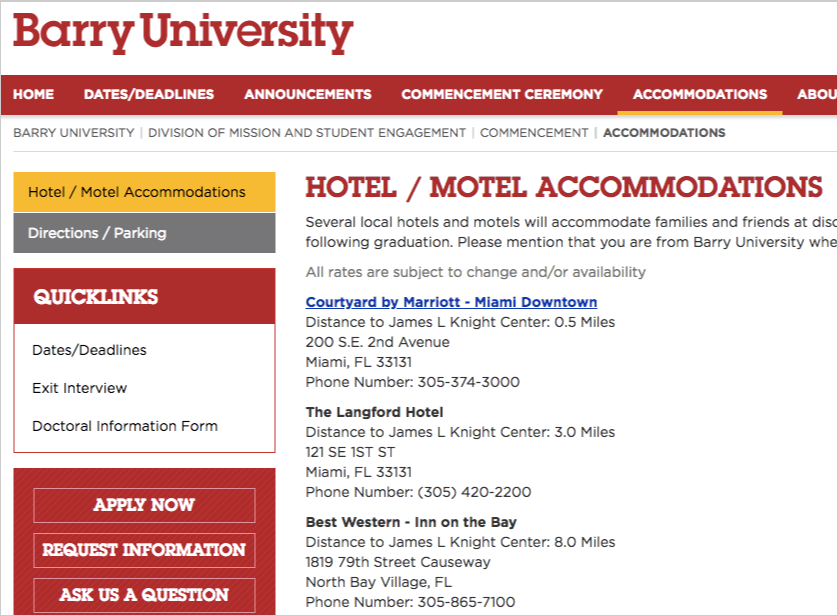
A lot of these pages are easy to find with a couple of search queries in hand. Below are some of them:
- site:.edu intitle:"accommodations" "hotels"
- site:.edu intitle:"accommodations" "hotels" [location]
- site:.edu "accommodations" "hotels"
- site:.edu "accommodations" "hotels" [location]
One note to make is to qualify pages with section or category title of "preferred hotels". Preferred hotels, as implied are ones picked by the university and may not be receptive to outreach that ask for inclusion of hotels without any prior connections with them.
PLAN YOUR VISIT PAGES
Travel enthusiasts want easy guides or simple itineraries for their trips. Therefore, a lot of bloggers and link curators started to create pages just for that - plan your visit pages.
One addition to your hotel website's link building plan is to pursue links from these pages. Those link opportunities also have their own categories for hotels, giving you the confidence that they link out to hotel pages.
You can use any of the following search queries to collect a list of "plan your visit" pages:
- intitle:"plan your visit" "hotels" [location]
- inurl:"plan your visit" "hotels" [location]
- "plan your visit" "hotels" [location]
Location matters for this link type so ensure that you only look out for plan your visit pages that are within region scope of your hotel brand.
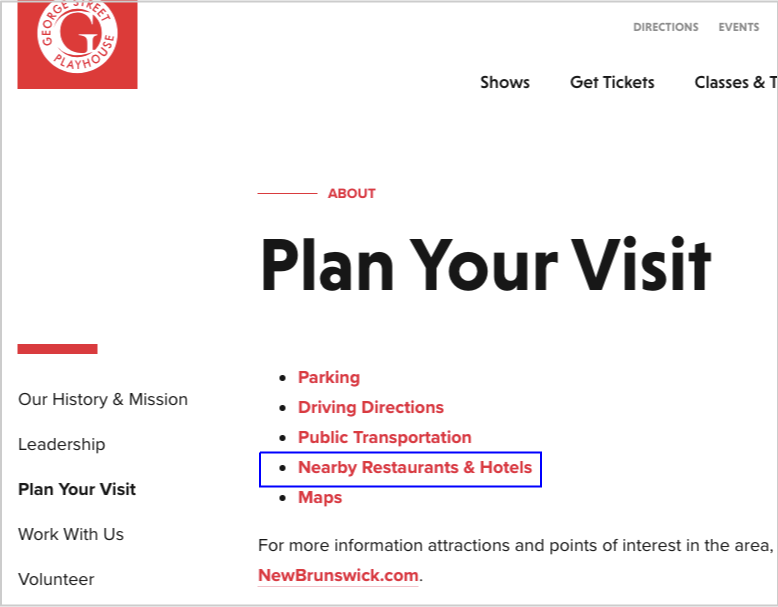
Once you've scoured the search for this type of link target, find your contact persons, and reach out for link inclusion of your hotel pages.
OTHER USEFUL ASSETS:
Let me give you some more link building ideas for your hotel link building campaign.
Attractions - acquire links by contacting local attractions in your region or city. Local attractions like museums, zoos, and theme parks have their own websites that you can get links and potential assisted conversions (visitors looking to book accommodations in your hotel site).
Pet-friendly hotels pages - Does your hotel welcome pets? Be cited on websites like TakeYourPet.com and BringFido.com plus other resource pages that link out to pet-friendly hotels.

Venues in [Location] - if you provide rental offerings for venues during weddings, birthdays, and other occasions, you can search for listing pages that link out to hotels people that have rental venues.
You can use either of these Google search queries: "event vendors" [location] or intitle:"venues in [location]". where [location] should be replaced by your city served by your hotel brand.
Need help with your outreach campaigns? Check out our link building services here.
Link Building for Dentists
If you own a dental website and is struggling to build links for a local dental SEO campaign, this guide is for you.
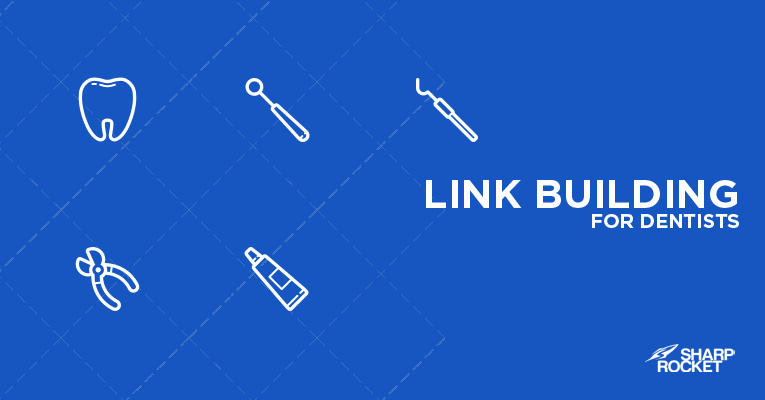

We'll cover untapped link building ideas for content outreach in the dental field, which interestingly can also be used in other health niche verticals.
Let's start.
Table of Contents
LINKABLE CONTENT CREATION
I'll never argue if content is king or queen. What's more important is that you need to publish a content that an audience will link to organically and manually.
In most dental business owners that I talk to and work with, they often wait for organic links. Organic linking or link earning (a common term for it) doesn't have a definite time when and predictable source where other publishers will see your content and link to it.
So if a writer wants to publish a post on "helping your kids overcome their fear on dentists" and is researching for additional references for his post, you hope that he ends up on your page after a Google search and considers your content as a supplementary reference to his future content piece. That's how natural linking works.
On the other hand, when I say manually, you need to do outreach to publishers and link curators and persuade them that your content is good and that it deserves a link. You publish the content but you need to do due diligence to let your audience know of your newest post.
One manual link acquisition strategy for dental clinic websites is creating a solid content that touches an audience ready to link. It's a mission-driven approach in content marketing given that you are serving a particular need of an audience.
For example, one core audience I've seen not all dental blogs tapped onto in content creation is kids. Even if they do, I don't see them promoting their content piece massively to this audience type.


We all know that kids need to overcome their fear of the dentist. You rarely find a kid who is so confident to face his or her tooth doctor. Teaching them about dental cavities will help them overcome fears and enjoy a dental experience.
You can capitalize on that topic by creating a guide for kids and parents to help their children understand dental cavities.
DENTAL CAVITIES
A guide about "Kids Guide to Dental Cavities" is one example of content piece that best suits that.
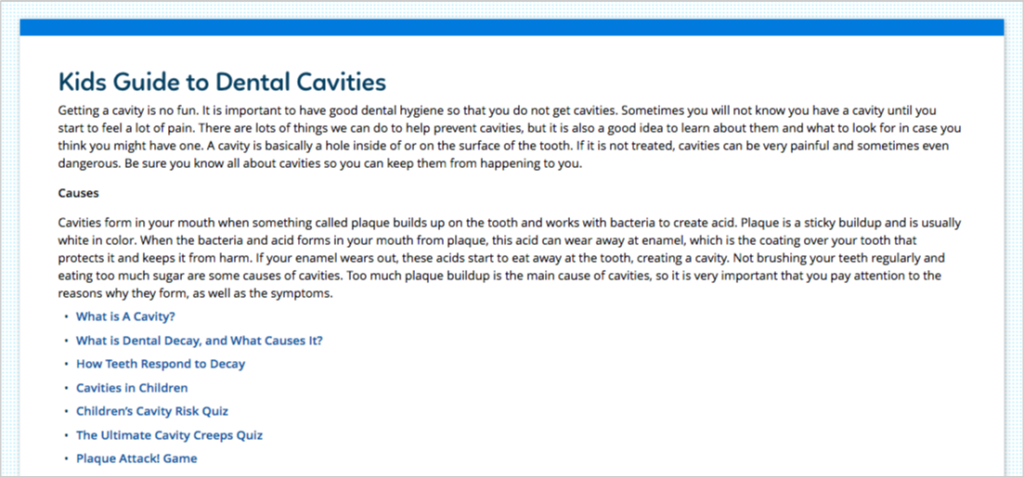

Of course, you won't stop just by creating the content. You need to do manual outreach to promote what you've published.
And you won't start your outreach with prospects on hand. From scratch, you start your campaign by finding suitable link targets.
The right prospects for this specific dental guide are resource pages of elementary websites about kids’ health. These are pages not typically being pitched by link builders and one you'd probably have to take advantage of.
So in order to find them, you can do a Google search for this search query: inurl:sharpschool.com/ "kids health" ~resources.
You may also use these other search queries for Google search:
- "elementary school" kids health ~resources
- intitle:school district "kids health"
- intitle:school district "useful websites for parents"
- intitle:school district useful websites for parents
- inurl:"kids health" ~resources.
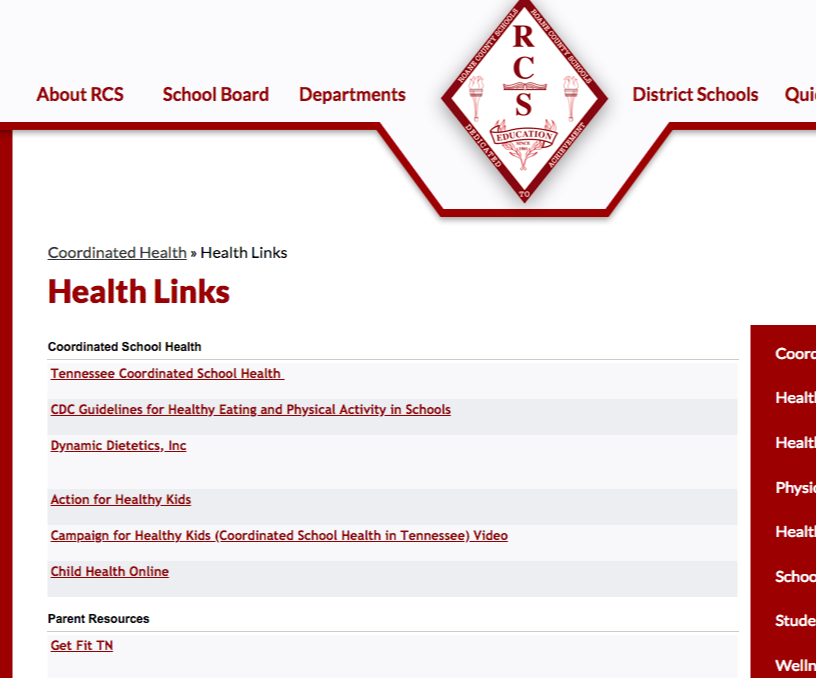

What you will find then is a set of kids health link opportunities that can potentially link to your Kids Guide content.
Your next step is to identify who to contact for each resource page (should be the person who manages or edits the page). Collect their email addresses and execute a proper outreach campaign to get links from them.
DENTAL ANATOMY
Another elementary education guide you can create and publish is a dental anatomy piece.
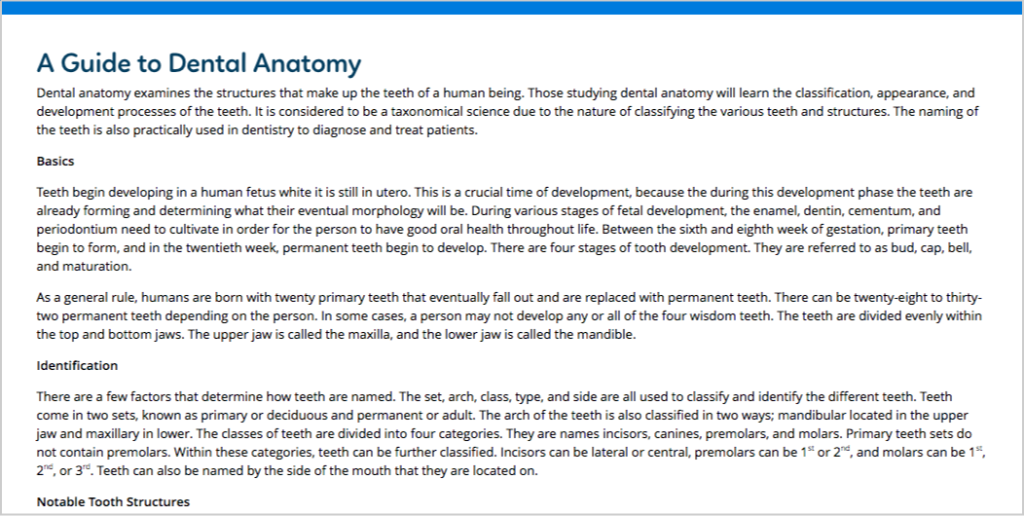

There are several science-based pages for kids waiting to link to anatomy guides.
You can find those link opportunities by doing a Google search for, intitle:fun science sites.
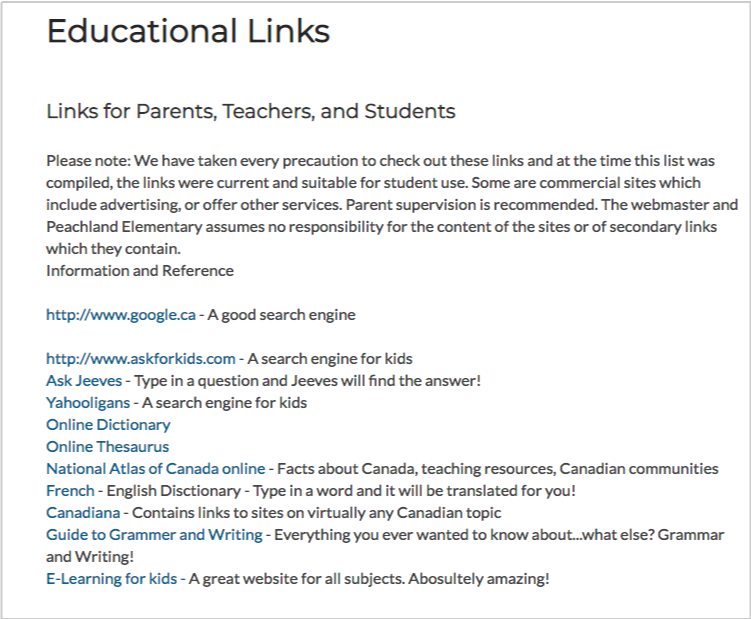

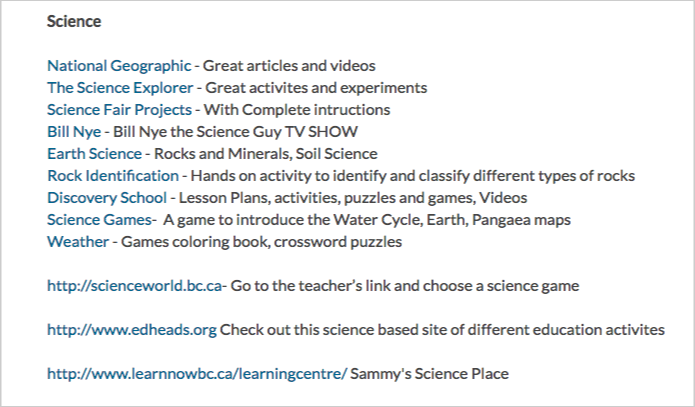

Here are other useful search queries you can also try out for link research:
- intitle:"fun sites" "kids"
- intitle:links educational science kids
- intitle:"kids links" science
- intitle:"educational links"
Similar with Kids guide to dental cavities, you do an outreach for resource page curators.
For our last linkable idea for dentist websites, there is another audience that Brian Dean considers "shoulder niche" - not the specific audience in your industry but is more likely to provide you with links--that audience is anthropologists.
ANTHROPOLOGY
You'll find that there are hundreds, if not thousands of pages about anthropology of any kinds.
So if you can create a historical and comprehensive guide about "Dental Anthropology and Bioarchaeology", it would be another link acquisition campaign you can leverage on.
You can do a Google search using any of the following search queries to find anthropology-specific resource pages:
- "Archaeological Links" ~resources
- intitle:Archaeological Links ~resources
- inurl:links.html "archaeological"
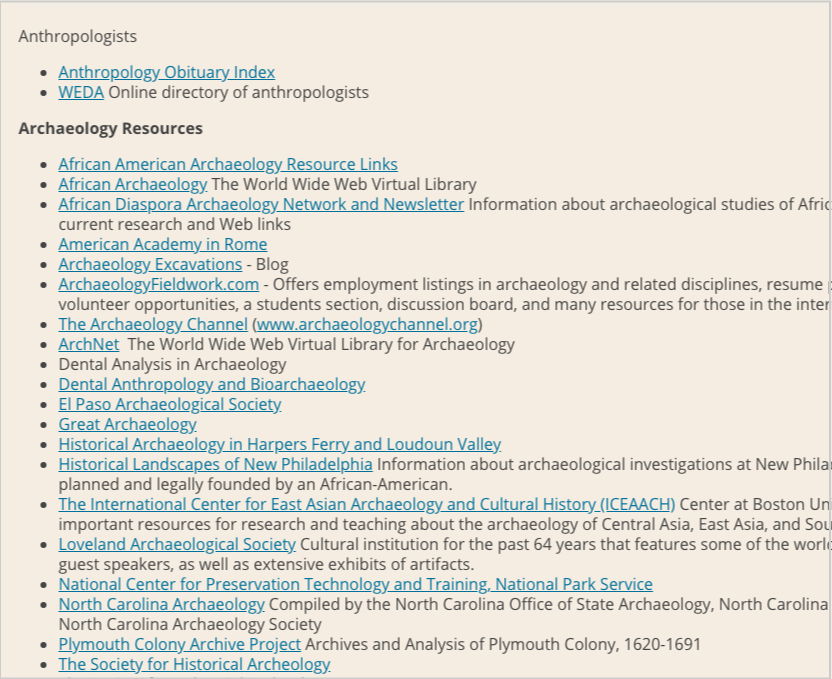

For outreach, below are some several guides that I've written in the past specifically to doing outreach for resource page curators.
Further Resources:
- Conduct Outreach Section of Broken Link Building Guide
- Broken Link Replacements for Better Link Conversion
LEVERAGE LOCAL RELATIONSHIPS
Not all of your link building efforts for dentist websites can be tied to content creation. One link building idea can simply be about maximizing your existing relationships.
I've covered this section on leveraging existing relationships for links in my link building post for drug rehab centers.
But that tactic can also be executed for other niches like dental industry.
Check any of the current relationships you have right now based on the following categories and see which one you can leverage for links.
- local charities you've supported (habitat, religious groups, little league boosters, etc.)
- local business initiatives (tourism & merchant association, "buy local", etc.)
- chamber of commerce and local service organizations
- dental suppliers and manufacturers
I recommend you read this entire guide on building links via existing relationships.
CUSTOMIZED MICRO LINK DEVELOMPENT CAMPAIGNS
This section covers customizing content to different types of pages/sites to get the maximum impact of conversions of links.
Here are some assets you can think of and get to used consistently for your dental clinic website:
- regular columns for top-tier dental or health-related publishers
- local online newspaper
- publications for trade associations
- guest content for parenting websites
- coupon codes for employees and students
One last thing. You may submit your dental business information to dental directories to win some good links at the start.
If you are looking for more link building advice and tips, subscribe to the email optin below to get notified of new posts.
Link Building Ideas for .EDU Website
Identifying your strengths as a brand is critically important in securing backlinks for your website. There are under-utilized resources you have to see and maximize to get the optimal results for your link building campaign
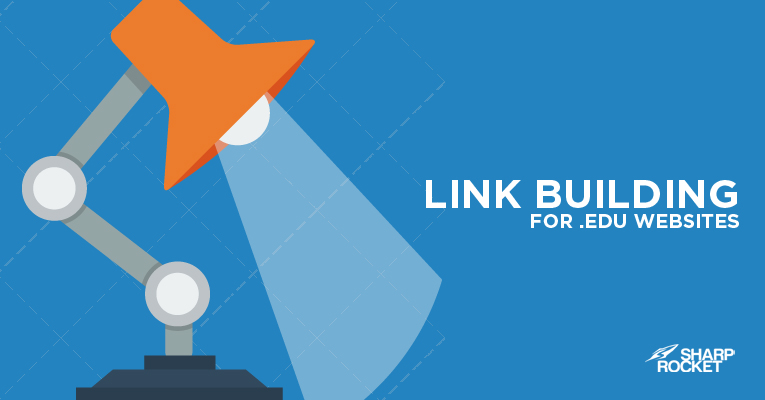

In doing link building for education entities, for example, there are pages that only such kind of website can create. These under-promoted web pages are only waiting to be amplified to its intended audience to gain some more links.
So the question is, "what are these solid pages and how you can best use them to get links to your .edu website?".
Before we reach into the nitty-gritty on how you can build links in the education space. Let's first answer the question.
Do universities hire link builders or do they really need link building for their marketing campaigns?
In our current experience working with a couple of educational institutions and colleges, we've found two reasons why outsourcing to a link building service provider is one of their options to execute a link building campaign for their website.
First, new course programs and offerings need immediate traction.
Though educational entities can resort to paid online marketing means to get eyeballs for their new course offerings, they always look for organic means that will result to long-term effect promotion for their new pages.
Second, educational entity or college produces a lot of link-worthy pages but aren't earning their deserved promotion.
With link building, it's not only pursuing backlinks for the .edu site, but goes beyond than that - additional branding opportunities and maximizing exposure for under-promoted assets.
With the help of new incoming links built from intentional manual link building efforts, it wouldn't be impossible for some pages to rank, earn some links, and receive more exposure.
Now let's discuss pages in an .edu website that are already or could possibly be link-worthy.
Table of Contents
1. HOMEPAGE
The homepage of a .edu website is itself a linkable asset, given its nature of being linked to on quotes and mentions on different web sources such as blogs, news, and even curated listings like resource pages.
It is best to setup alerts to monitor regularly any mentions of your brand name. You can identify websites that have mentioned your brand but haven't credited you with links.
Reach out to webmasters of these sites and ask for an appropriate links for your page.
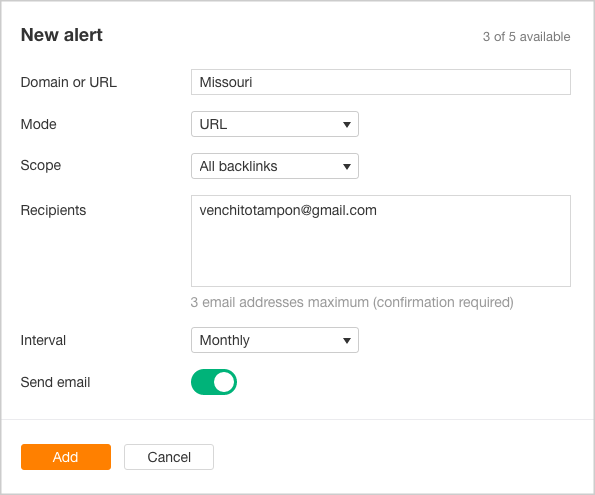

Another way to maximize the authority of a .edu homepage is to find specific resource pages that list down colleges or universities.
I recommend that you start with a macro view of lists pages (i.e. Australian colleges) before going to prospect for geo-specific links pages (e.g. Melbourne colleges).
Here are some key phrases you can use to search for relevant resource pages to get homepage links:
- list [country/city] college
- list [country/city] school
- listing [country/city] i colleges
- listing [country/city] school
- list “[country/city] colleges”
- [country/city] colleges list
- listing [country/city] college
- [country/city] school list
- [country/city] school listing
Reach out to point persons of these curated listings and ask to be included on their pages.
2. SPECIALIZED ONLINE DEGREE PROGRAMS
While you can already build relevant links with the first asset, this second linkable page can give you a more category-specific link equity that can boost your educational degree programs.
The deeper the page is in its category, the more relevant a link should be acquired.
There are a lot of factors that come into play when we build links to online degree programs.
The first one is specialization. How unique your page is can impacts its linkability in outreach. For example, we've had a .edu client who recently offered a "Leadership Master's Degree online program". It is more specialized compared to masters degree programs we all know. That specialization in online degree program allows us to get valuable links from certain pages about a clearly defined topic - leadership in business.
Here are a few examples of niche-specific resource pages for degree programs:
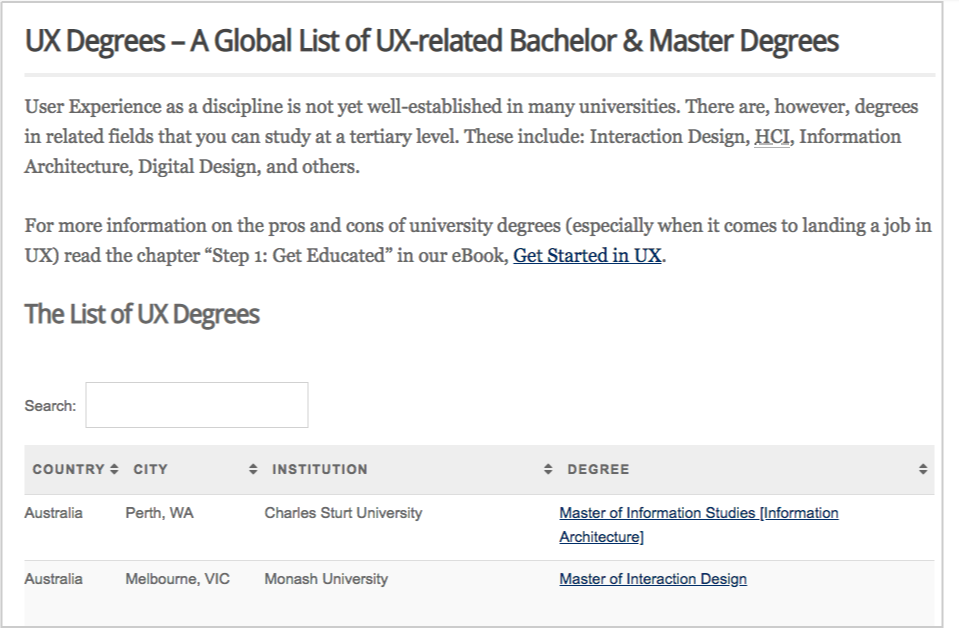

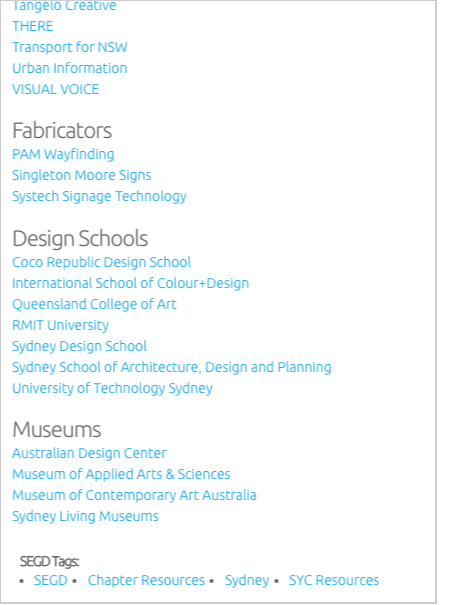

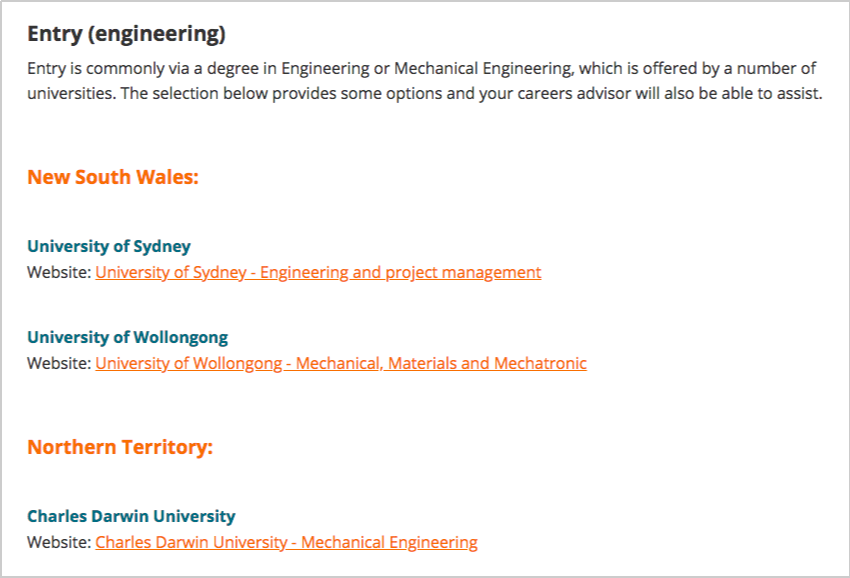

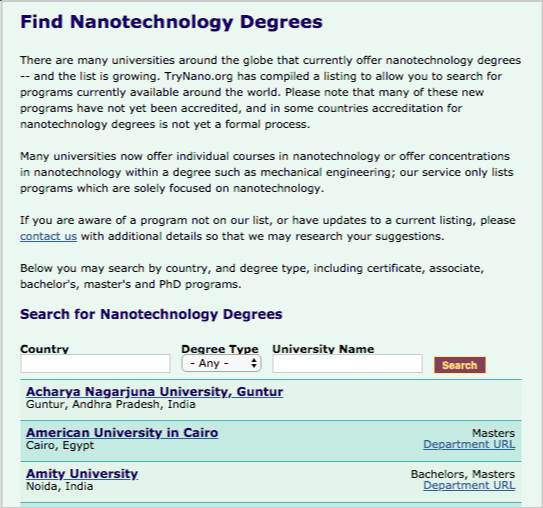

You can find these pages by using any of the following keyphrases (for Google prospecting):
- Engineering degrees in [country/city] list
- listing of ux degrees [country/city]
- inurl:links design degrees [country/city]
Replace niche degrees (engineering/ux/design degrees) with each of the specialized degree programs of your .edu website. By using them for Google search, you'll find a couple of prospects for one degree program and a few for the other pages.
The next step requires groundwork filtering resource pages that match relevance of your degree programs. You won’t get hundreds of pages listing specialized online degree programs all the time, especially if you're targeting country or geo-specific pages. But those few prospects you've found for a specialized degree program are worth pursuing in outreach if you can get just a handful of high-quality links.
3. BLOG LINKS IN THE CAREER SPACE
One of the easiest verticals to gain advantage in link acquisition for .edu websites is career space.
With all of the career blogs publishing job searching articles, there is always a room for very-specific content.
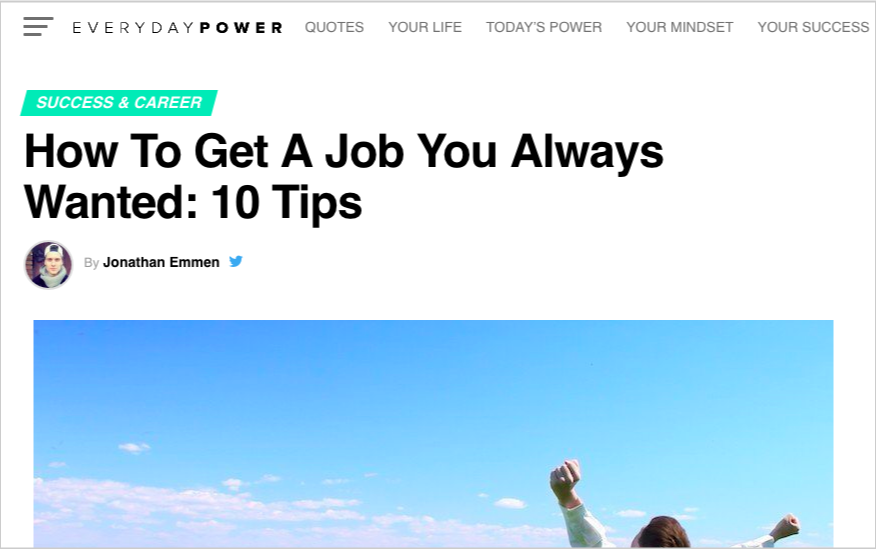

Instead of submitting generic guest post pitches to these career blogs, why not give them a very unique content they haven't published yet? A "how to get a job in [niche]" is a topic they won't hesitate to publish, especially if you have crafted an expert-oriented content on the topic.
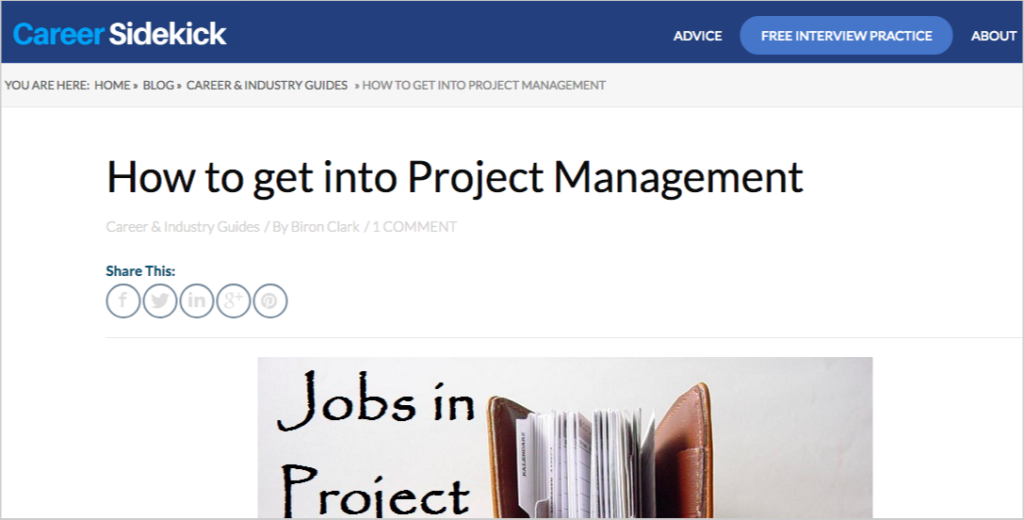

In addition, you can also maximize your guest content in career blogs to acquire contextual links to your sales pages - your online degree programs.
When appropriate in context, those sales external links can justifiably be inserted in guest articles.
Further Reading:
4. APPRENTICESHIPS
When maximizing link opportunities for a given website, you have to identify pages that aren't linkable at the first glance, as it doesn't have any much information to offer. By searching for Inurl:"resources" "TOPIC PAGE", you could be possibly find an opportunity that could result to 10s if not 100s of links.
One example of this type of opportunity are apprenticeship links.
When you have an "apprenticeship" page on your site, try to look for useful resources pages that links out to universities who offers apprenticeship, traineeship and even pre-apprenticeships programs.
A pre-apprenticeship program basically you basic skills in your interest area and readies you for an apprenticeship.
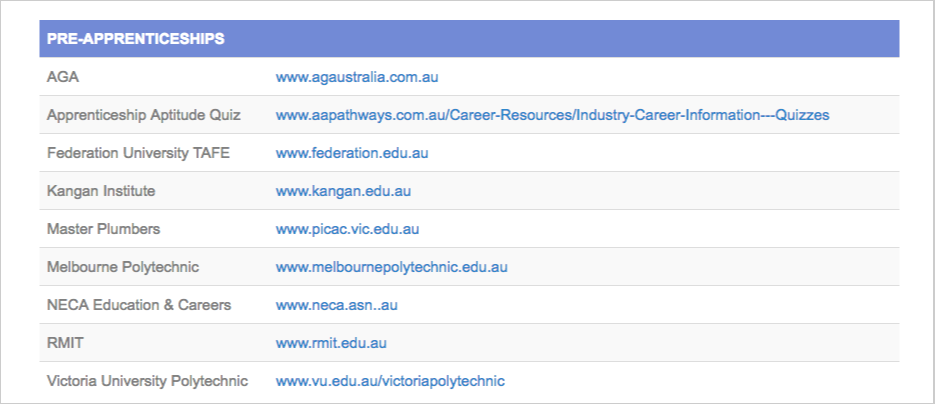

You can do a Google search using any of the following queries:
- "apprenticeship" inurl:links
- "traineeship" inurl:links
- "pre-apprenticeship" inurl:links
Reach out to persons who manage those pages and get your site or apprenticeship page be included.
OTHER USEFUL LINKABLE ASSETS:
Here are just a few pages you could take advantage and explore more link opportunities. One could result to another linkable idea that will help you earn more links to your educational entity.
- Newsworthy events (faculty changes, new building constructions, new program creation and development) International and local awards and certifications of students and teachers
- Literary and academic researches of professors, researchers and other knowledge workers
- Speaking engagements and opportunities
- Student blog section
- Visual assets and how-to guides
- Informative and comprehensive health and wellness, counseling and safety pages
- Library guides sections
- External works (involvement in charities, scholarship opportunities, local and community events, etc..)
Need help with your outreach campaigns? Check out our link building services here.
Securing Backlinks for Drug Rehab Centers
The addiction space is one of the easiest vertical we've found to build links in. With a couple of scalable link building strategies to execute on, you'll be able to generate high-quality backlinks consistently to your site.
Side note: In case you don't own or work with drug rehab centers, I've covered niche-specfiic link acquisition strategy for other industries like fashion, real estate and lawyers.
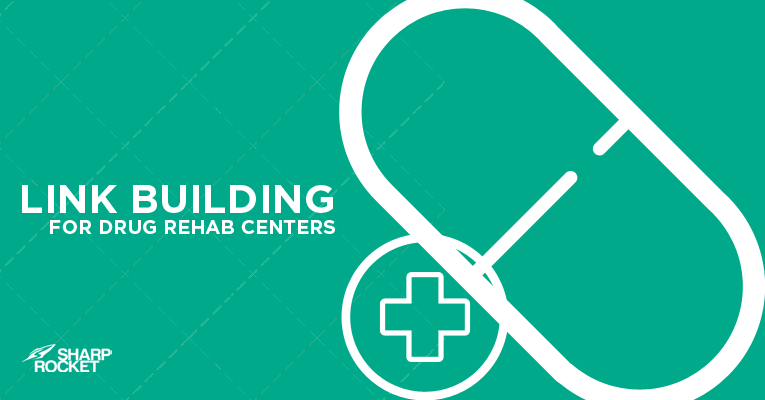

If you're looking to get links to drug rehab center websites, here are link building tips you can play around and maximize for your campaign.
Table of Contents
Let's start with low-hanging fruits: relationships.
LEVERAGE EXISTING RELATIONSHIPS
One of the common obstacles in link acquisition is creating rapports with potential link partners who don't have any idea of what your business is all about. Whether you contact them via phone or email, you don't have any control of the possible conversions and the timeframe of actual link placements.
Leveraging existing relationships is one of the most commonly cited but rarely explained link building advice in the local scene. Reaching out to your existing contacts and pleading them "they link to you", will not work.
There are seven easy-to-follow steps to ensure you're getting the most out of your existing relationships:
- Identify who you know who can potentially link to your website
- Determine what kind of online asset will appeal to each individual
- Reach out to every individual about the asset you can provide
- Create the online asset
- Send a compelling email with a clear call-to-action
- Follow up and ensure quality with kind persistence,
- Handwritten thank you card
You can read more of each step in ZipSprout's article on, "Local link building via existing relationships",
It is best to have proper inputs and specific actions for each existing contact. One proper way to do that is to create a spreadsheet to organize them all. Here is a sample spreadsheet from Ziprout.
One example of an existing contact you can leverage with is production events you've partnered with for media purposes.
They have a dedicated page for media partners where they list down and link to each of their media partners.
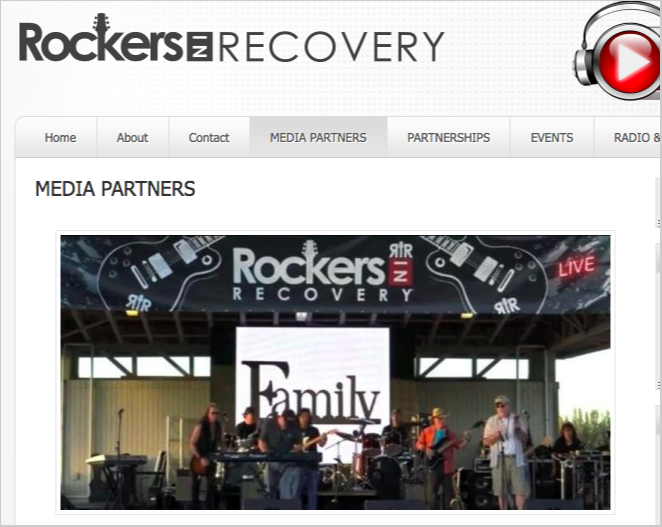

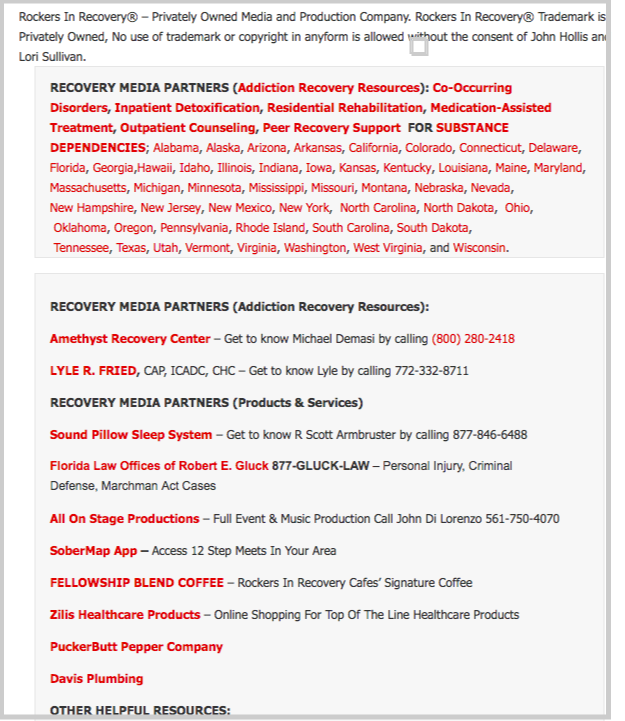

If you've had this kind of partnerships in the past, better to gather their contacts and reach out to them for adding links to your site.
ADDICTION CENTER AND LOCAL BUSINESS LISTINGS
Another two low-hanging fruits in link building for drug rehab centers are submitting business information to local citation sites and getting links from business and local directories.
Both are quick wins in your first-month link acquisition campaign.
Here are websites you can submit business information and/or create business profiles from:
Addiction
Business Profiles
LOW-COST LINK PROSPECTING
We heavily relied on two link sources in collecting resource pages: search engines and Citation Labs Link Prospector.
You'll have to use both methodologies to know which one would yield better results for your link prospecting campaigns.
What I've found is that there are a lot of noises one has to remove in filtering Google search result pages, even if they have used proper advanced search operators and addiction industry keywords.
While in Citation Labs Link Prospector, there is less noise one will be able to avoid by creating a Global Exclusions list to ensure specific websites will automatically be removed in the sourced out lists.


I've shared a step by step process on how to prospect for resource pages using Citation Labs Link Prospector in this broken link building guide.
Pro tip: When running out of best industry phrases or keywords to use for link prospecting, you can use TagCloud to generate new keywords you haven't used for your past link prospecting initiatives.
We input Page Titles of our first set of resource pages (we use Page Titles inputs to customize our email templates in outreach, making it more relevant to end recipients).
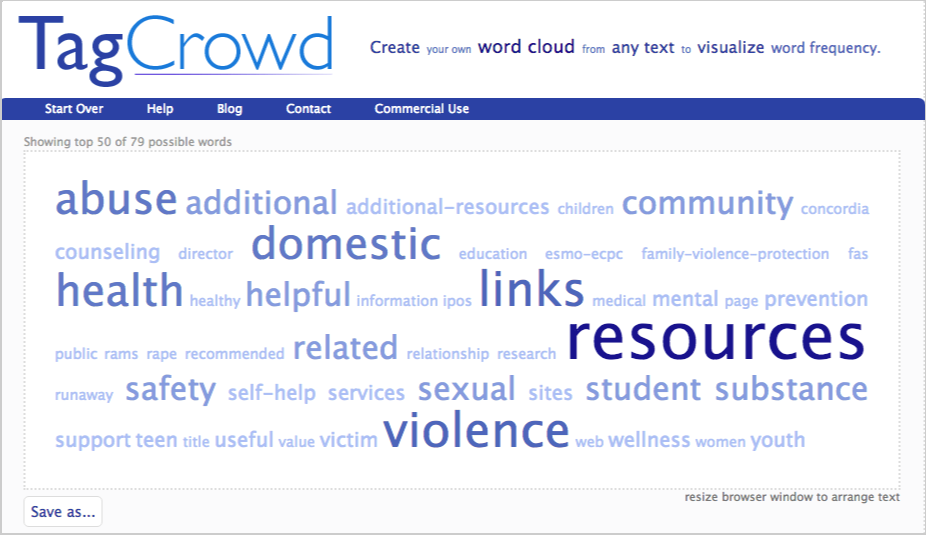

You'll be surprised by how many keywords you can generate using the said approach.
COMPETITOR ANALYSIS
If you're starting from the ground or middle-level, you have to look and analyze how your competitors (from a national or local-centric approach) are creating linkable assets and generating manual or natural links to their sites.
By doing that, you'll be able to see patterns of approaches you can replicate and innovate to even get better results than what they did.
One pattern is a similarity in audiences they're tapping on.
Look at your competitors' top pages and see where most of their inbound links are pointing to. When you scale that to different websites, you'll see a pattern of audiences that they normally target for linkable assets. That's when you can start creating content pieces that have a high likelihood of generating links.
Pro tip: You can analyze on a resources or blog section level to specify top-of-the-funnel pages that are getting links.
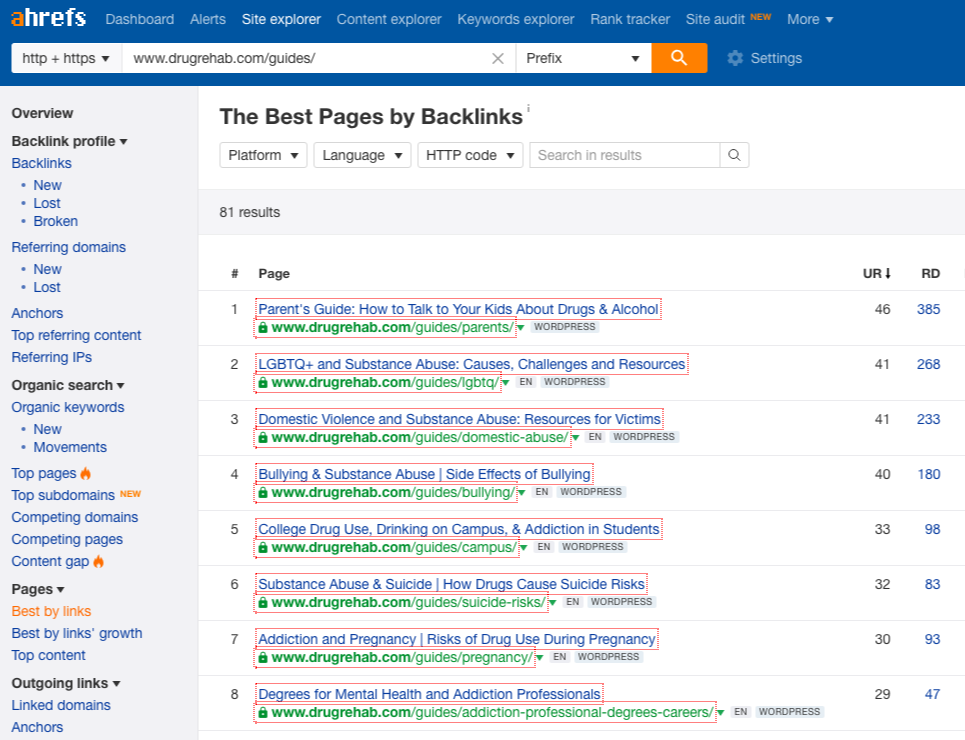
CATCH NEW COMPETITORS
As you go along with your search, you'll find new competitors along the way that are still building their brand from scratch. Got a low authority level and is entirely new in the drug rehab industry.
I often dive in to their links and top pages reports to see if they're doing amazing tactics I could replicate to my client's campaign.
Pro tip: If you have landed in a page that links out to different linkable audiences, go a quick link profile analysis on each of the website and see if there are any linkable ideas that could be generated from their linking behavior and patterns.
Need help with your outreach campaigns? Check out our link building services here.
How to Find and Evaluate a Link Building Agency
The demand for high-quality links has grown over the years, as more and more companies see the need for further establishing a solid link acquisition campaign that'll heavily impact their websites' organic traffic performance.
With that burden, doing a specialized marketing in-house will require solid training and execution processes to consistently deliver certain KPIs of links.
Both of these necessitates effort and time to develop, and so, companies of any type or any size, are now looking for a specialized agency to partner with for their link building needs.


If you're looking for a link building agency that will best serve your needs, you need to find them, evaluate and choose one that fits you.
Table of Contents
How to Find a Link Building Agency
In general, there are a lot of references and platforms where you can source out a list of agencies to start evaluating.
You can start with these sources to get your list:
- Referrals from partners/companies you've known outsourcing their link building work to others.
- Contributors on top authority sites with highly restricted editorial guidelines (i.e. Moz, SearchEngineLand, Ahrefs), and blog about link building.
- Speakers of local events with mind-blowing presentations on link building.
- Ranking agencies on search engines for keyphrases, "link building company" or "link building services".
You don't need to spend weeks in getting your initial list. The next step is what you should be investing your time in - evaluating a link building agency.
How to Evaluate a Link Building Agency
Assuming you've contacted a potential link building partner and scheduled a call with them, here are inputs you should definitely ask questions about and get answers at the end of your discussion.
1. KPIs (Key Performance Indicators)
It's critically important to know how you can track their performance. Do they both have lagging and leading indicators? Leading indicator is links they produce on a monthly basis while lagging indicator is the search traffic they've generated from content assets they've created.
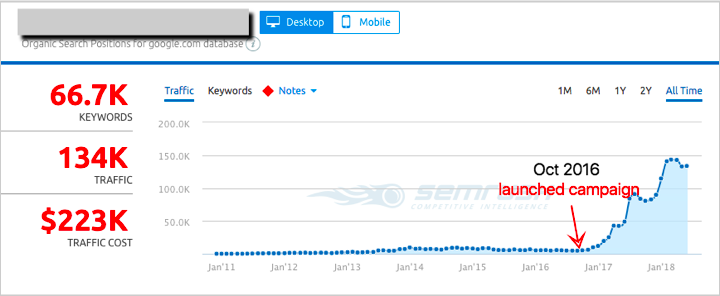

Knowing that allows both of you to set expectations on what to deliver and what kind of report should be presented at the end of each month or project period.
In most cases, you'll find link building agencies whose main offering is a support to the overall full-SEO campaign of a business (which happens generally with SEO agencies outsourcing their link building projects to the firm).
Primarily, those support link building agencies provides deliverables of live links they've acquired for their clients - excluding any reports of organic traffic performance of the website.
Given support link building agencies don't have a full control over the website, specifics to technical SEO and content management, and whose main focus is on external link acquisition (guest publishing, link reclamation and broken link building), you shall expect reports of ONLY links acquired, not the impact of them to organic traffic performance.
The question maybe good to ask is, what's the value of links? If it's not the organic traffic performance that'll be reported, how do you ensure those links will have an impact to your clients or websites?
That leads to second input.
2. Case Studies
Every link building agency should have a document of their case studies.
Link building case studies will help you know they'd helped their past and current clients grow. Though they may not have a full control over the entire full SEO campaign, links they've acquired should have a significant impact to the site's organic traffic.
Ask if they have worked with clients within your sector or in similar markets. This brings familiarity in the market and provide suggestions as to what link building strategy best fits for that and what types of resources are needed to acquire high-quality links.
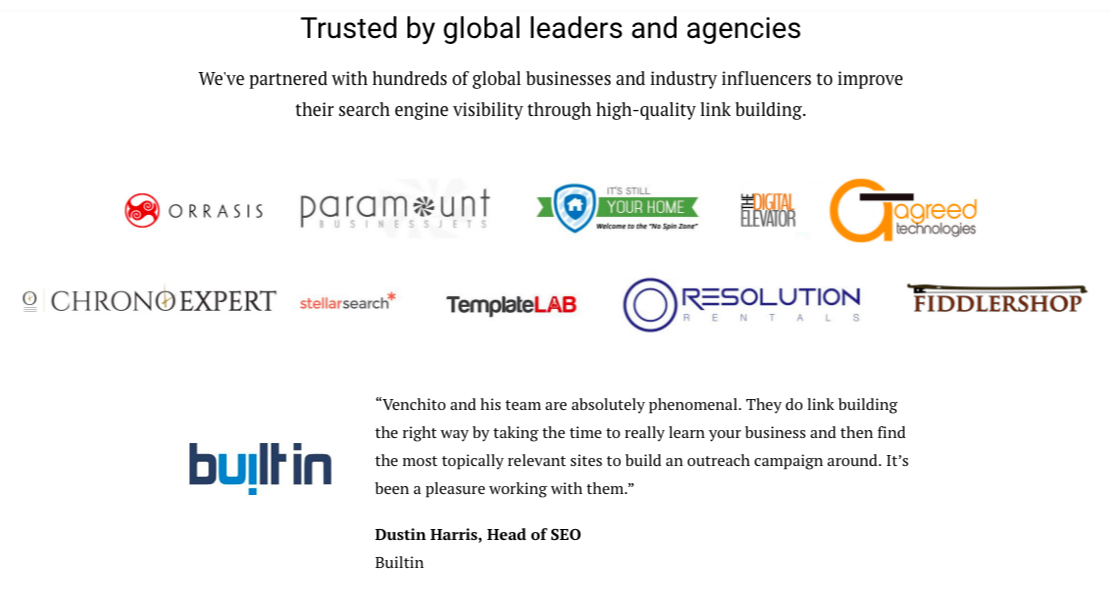

There would of course be agencies who didn't have any link building experience in your market, but you can discern if they are being transparent or trying to just be impressive with awful inputs.
3. Processes, Strategy and Tactics Used
Ask questions about your prospect link building agency's processes, link building strategy and tactics.
Your contact person (sales person, specialist or the agency owner himself) may not fully give you the details, but an overview of how they work, and their strategic recommendations is a big indicator for a successful beginning with your link building campaign.
It is best for you to know by yourself what are the current and effective link building strategies and what types of links that could make an impact to your website's traffic growth. This will help you gauge the ability of your prospect agency to depart from the inefficiency of some link building tactics and low-quality information within the SEO space.
4. Communication
Last but not the least, you shouldn't forget to ask about the contact person you'll get in touch once the partnership begins.
Perhaps, the agency director himself will be your contact person or you'll be assigned with a Project Manager. Whoever it is, that person should directly work with you for most of the following tasks:
- Orientation of the strategy and recommendations to kick-off the campaign
- Discussion on the resources needed from both parties
- Regular updates on the progress of the campaign
- Deliverability of reports or spreadsheets for live links in a given campaign period
There are a few reasons why you should have an idea of the link building agency's communication process:
- To eliminate unnecessary emails due to back and forth discussions with the people who are not involved in the campaign.
- To set clear objectives at the commencement of the campaign and have clear action plans to get there.
- To know what to expect from both parties to get things done
Overall, you want to be looking for an agency who can communicate with you a glimpse of their processes which will increase confidence and build trust to the partnership and will set realistic expectations on the campaign.
John Doherty created a platform that allows you to find a verified agency that aligns with your marketing goals.
If you have questions, feel free to comment below. And you can also follow me on Twitter @venchito14.
Tactical Guide to Never Running Out of Link Prospects
Agility and efficiency are essential drivers of a successful link prospecting phase.
Setting a plan to never run of opportunities for link acquisition is important, since this can improve the entire campaign's prospecting rate as well as increase the average number of link prospects collected per hour/day.
By focusing on link prospect growth, link builders can expect significant improvements in the overall link development campaign, in parts such as:
- Enables to find new audiences targeted by new added link opportunities, which can be useful in brainstorming future content assets relevant to these audiences.
- Grows your current list of relationships with bloggers/webmasters/journalists (new connections can be derived by reaching out to additional list of link opportunities).
- Increases deliverables (# of links delivered on a monthly basis) for clients, since on a given average conversion rate, one can expect more links by sending more outreach emails to added link opportunities in the original list.


Here are 9 tactical methodologies to never run of opportunities for your link acquisition campaign.
Table of Contents
1. USE "TOPIC" "GUIDE" TO SEARCH FOR CONTENT COMPETITORS
Reverse engineering has been a standard practice in link building - which is basically spying your competitors for link sources pointing to their pages.
However, that approach will leave you following the footprints of your competitors.
If you can be visible on websites they haven't acquired links from, it would be a better strategy to get ahead of them (or evenly outrank them!).
One initiative you can make is to look at other brands (not necessarily your direct competitors) that have published industry guides on similar topics.
We've found that using this search query, "GUIDE" "TOPIC" supplies a list of websites from other industries in SERPs that have topically-relevant content assets.
For example, a quick look for "veterans" "guide" can reveal this search result page.
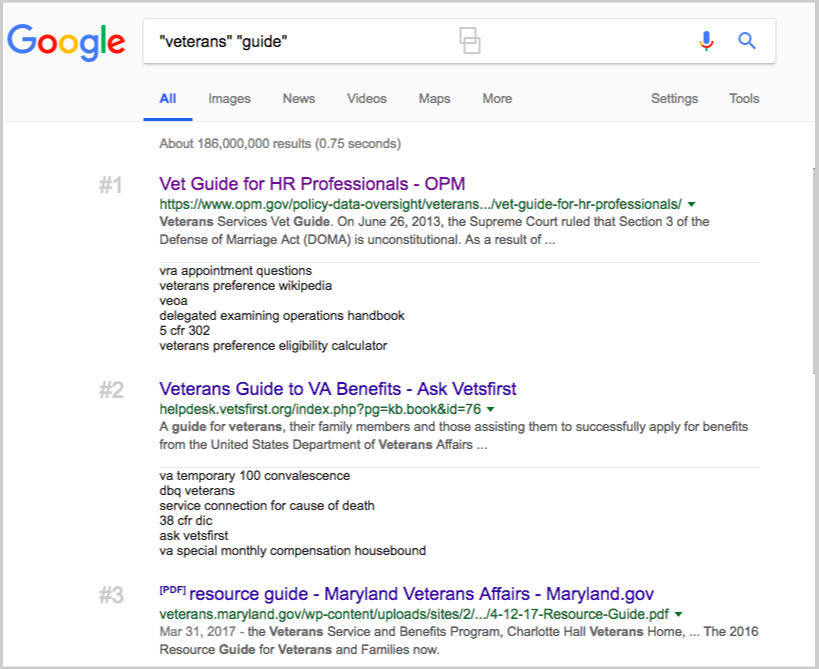

Your next step is to make a list of the people and sites/blogs who have linked to similar industry guides or have shared them via social media. You can extract these data using tools like Buzzsumo and Ahrefs.


It is best to list them down in a spreadsheet including each prospect's contact address.
Start reaching out to them. You'll have better chances of getting links given that they're interested about the subject of your content, since they've linked to a similar industry guide in the past.
2. KEEP TRACK OF WEBSITES WITH CONSISTENT LINKABLE CONTENT PRODUCTION
You will not always come across a brand that publishes a solid set of content assets while gets/attracts high-valued links to its pages.
If you have found a website that matches both of the above criteria, it's worthwhile to bookmark it and try to spy and assess their content strategy (both their content creation and promotion approaches).
In our broken link building campaigns, we've spot on and have kept track of all the websites that have continuously been producing heavy linkable assets in different industries.
Regardless of whether or not it is directly competing with our client, we monitor those sites for new content ideas and future linking opportunities.
For example, Affordable Colleges had been on my personal radar because they have been targeting new markets (audiences) through the new contents they published on their resource section.
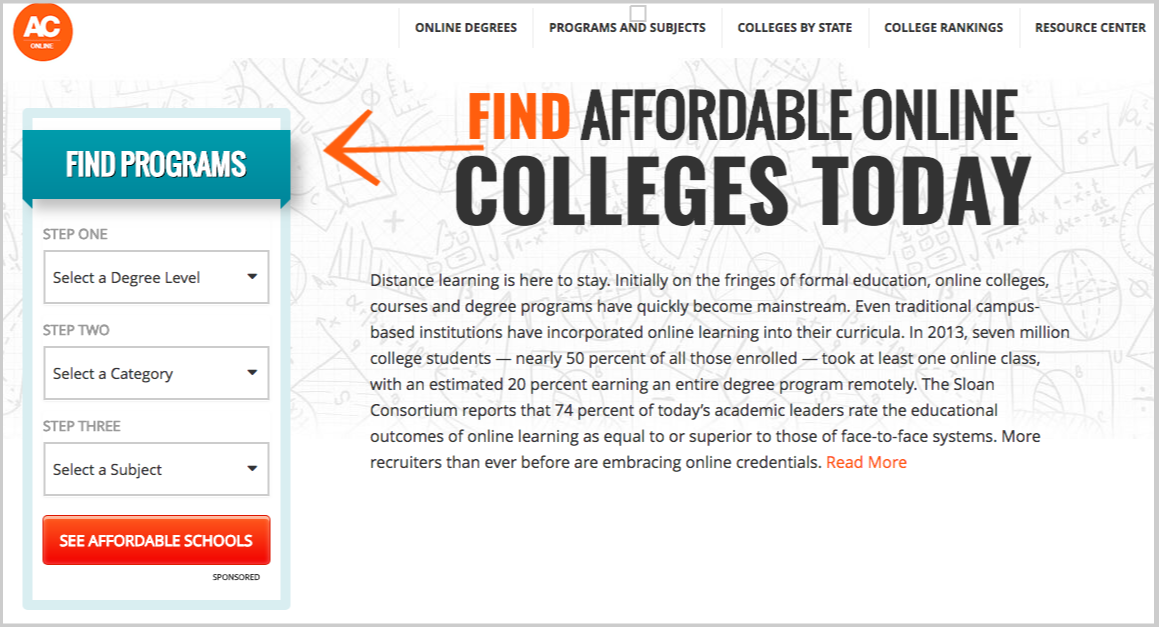

By using content analysis tools like Ahrefs, we can see their new industry guides they've invested heavily on content promotion (check Best by Links Growth feature).
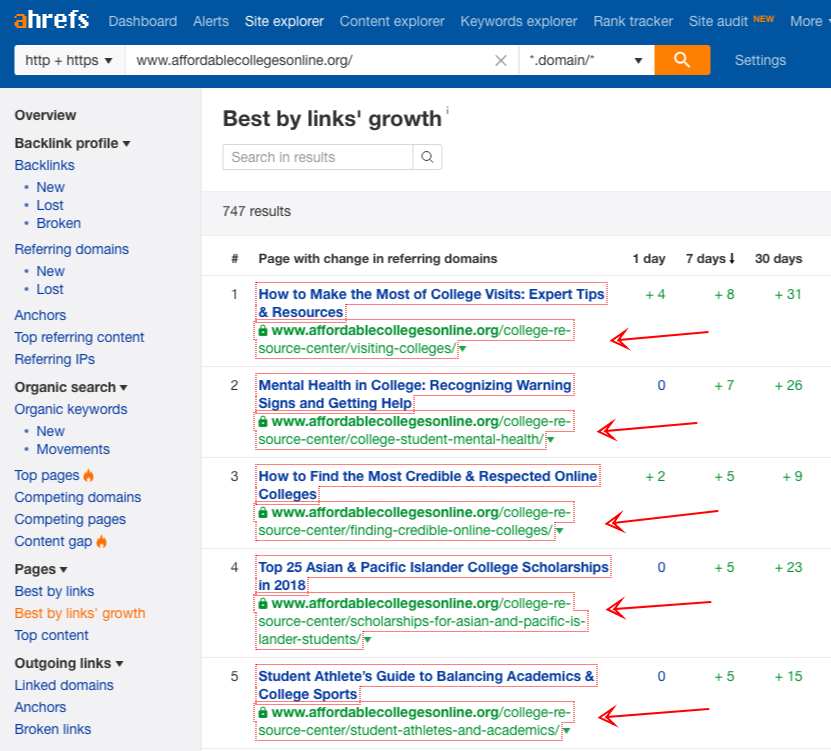

That approach can definitely expand opportunities for our future link development campaigns, given that we can tap into new markets that are not included in our initial list of linkable audiences, such as homeless students and multicultural & diversity groups.
3. INTEGRATE DEDICATED .EDU PAGES IN YOUR SEARCH QUERIES
Apparently, links from .edu pages is one type of links that can impact your pages' performance on search rankings and can really damage your industry's competition if you achieved success with it.
However, before getting results from any .edu link building strategies, you'll always start with .edu link prospecting - one that's hard to build when you're starting out.
One approach that you can use to scale .edu link prospecting is to target a specific type of .edu page in your search queries.
Those .edu websites normally have sections of information resources such as counseling, health & wellness, financial aid, community resources, and summer housing - which can be individually targeted in your search query depending on the subject of your page/site.
For instance, if you're in the mental health industry, one phrase you can include in search queries is "counseling" or "student health" to come up with the following targeted search queries:
- site:.edu "counseling" inurl:resources
- site:.edu "student health" inurl:resources
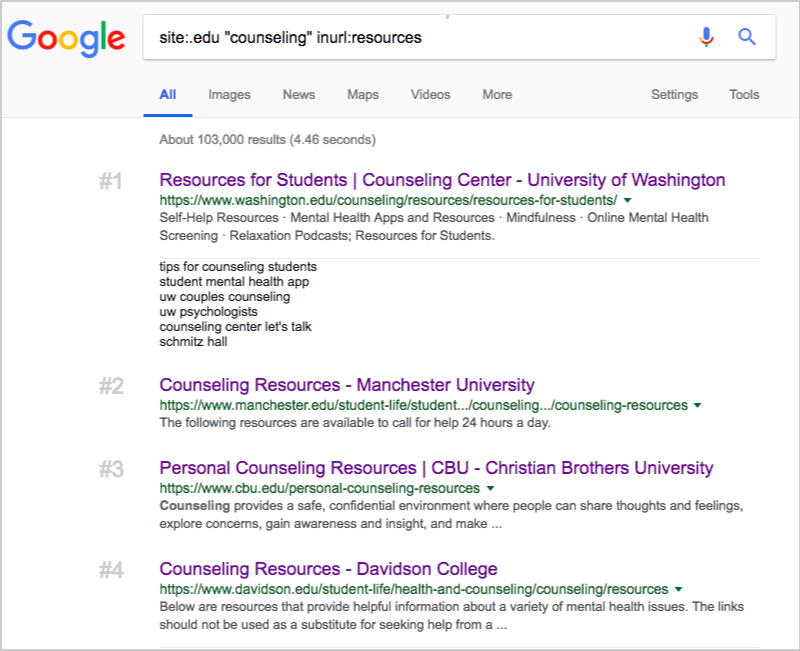

Here are more .edu pages for topical-relevant pages:
- "summer housing" - apartment categories
- "career & internship" - job sites, portals or resources
- "general health & wellness" - health organizations or niche-specific resource guides (e.g. sexual health)
Moreover, finding targeted pages of .edu sites can also be helpful with the kind of link building strategy you're currently using.
For example, when pursuing for scholarship links, instead of using the common search queries like (site:.edu "scholarships" "industry/topic"), you can be more targeted with your search by using the phrase, "financial aids" - which is a .edu resource page for students seeking for financial help.
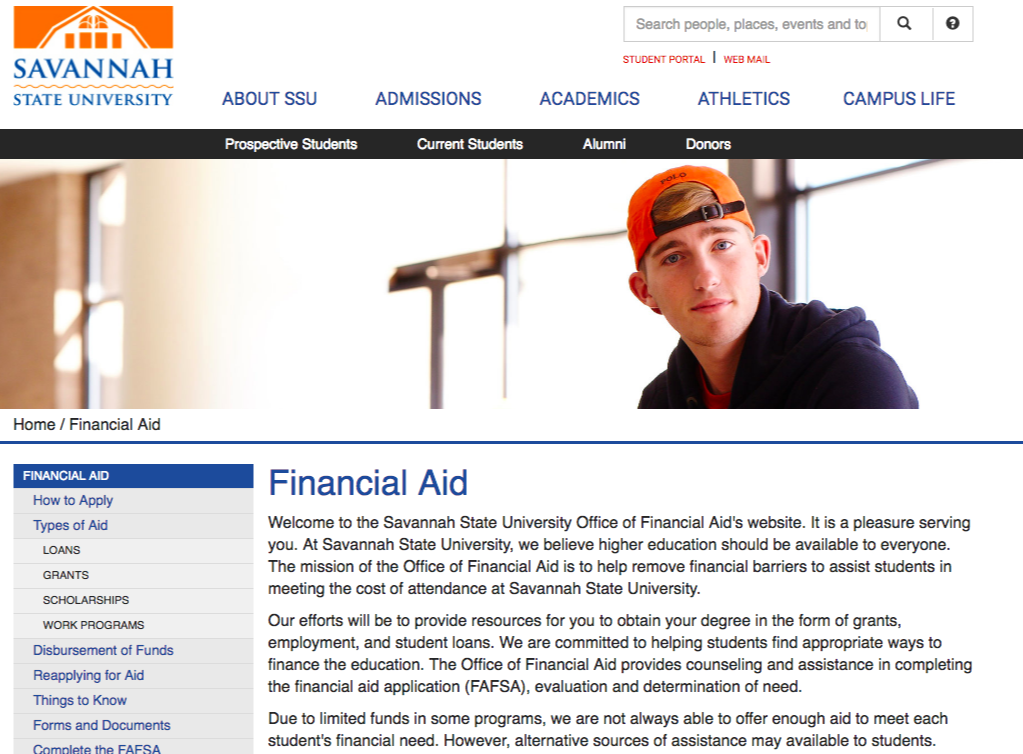
4. START WITH LIBGUIDES QUERIES FOR .EDU LINK PROSPECTS
Another way to be proficient in high-authority link prospecting is to target libguides pages of .edu websites.
What exactly are libguides?
LibGuides are a content management and information sharing system designed specifically for libraries. The platform allows for easy navigation through and instruction on core and relevant resources in a particular subject field, class, or assignment.
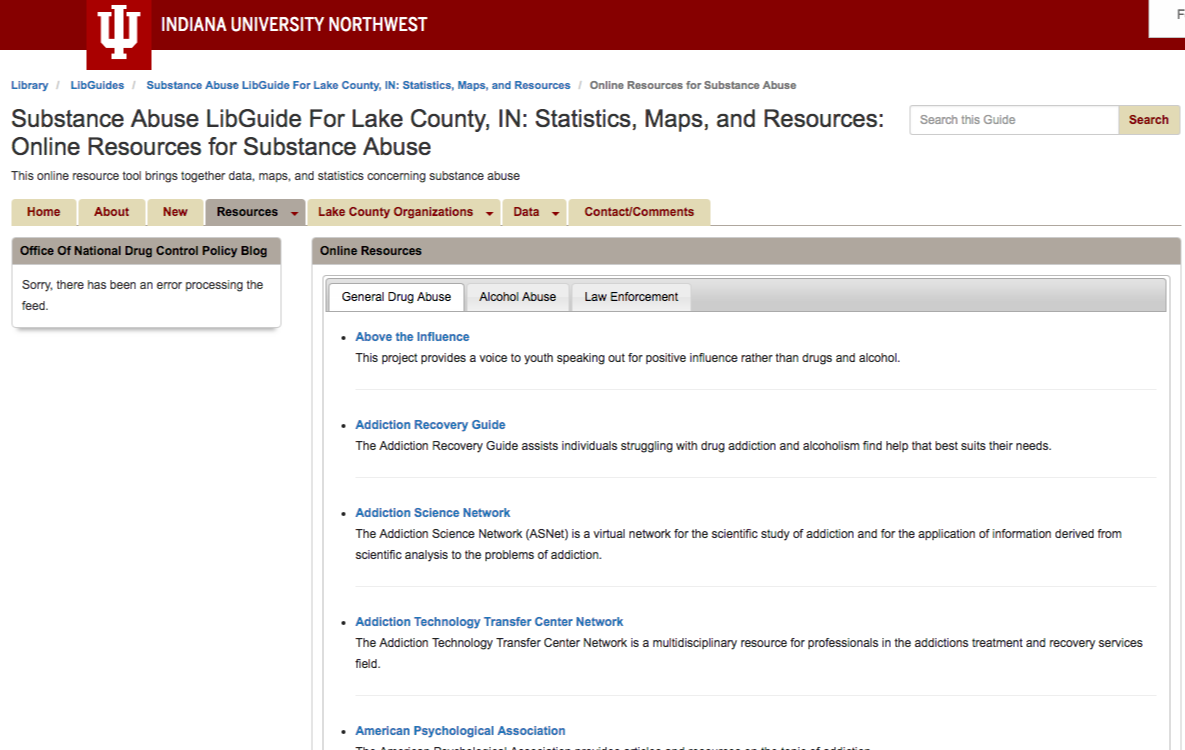

Libguides benefit students in many ways, such as:
- Allows students to focus on the relevant and sift out the less relevant.
- Visually demonstrates that there are great resources, in multiple formats, on even the most difficult topic. That reassurance builds the confidence of students who need to get started on their research.
You can see the other benefits of libguides to students here.
By definition and purpose, libguides are academic resource pages for students.
Given that they aren't updated that much, they usually contain broken links. Knowing that, you can use broken link building as an approach to acquire links from these high-value pages.
Resource page link building (or content suggestion) can also work as long as you have a high-utility content piece worthy of being referenced to by these academic pages.
How do you find these libguides?
You can do a Google search for inurl:libguide site:.edu "TOPIC" - replace the word topic with the subject of your content or website.
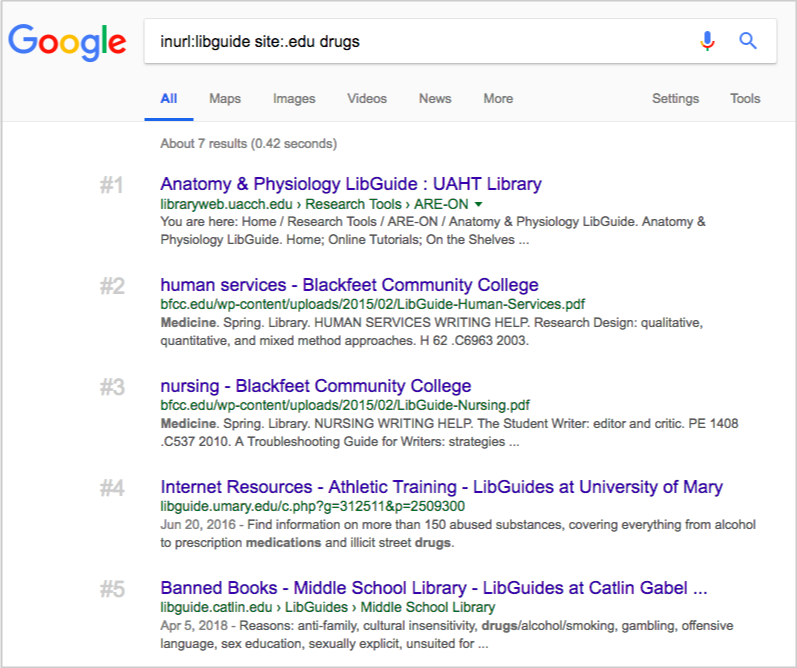

Before pitching to librarians (contact persons managing libguides) with a content published on your site/client, it is best to have a idea on what sorts of content, information, and content types that they prefer using as references.
Make sure you create the most comprehensive guide on the topic (or at least can match up to the resources that they've already linked to). If it's necessary to improve your content, do so to increase your chances of getting links from them.
5. SAVE LINK TARGETS OF LOWER METRICS
When prospecting for link opportunities, It's easy to overlook pages with lower metrics (i.e. <DA40), given that at the beginning of the campaign, link metrics has been set to use as a quality benchmark for all target pages/sites moving forward.
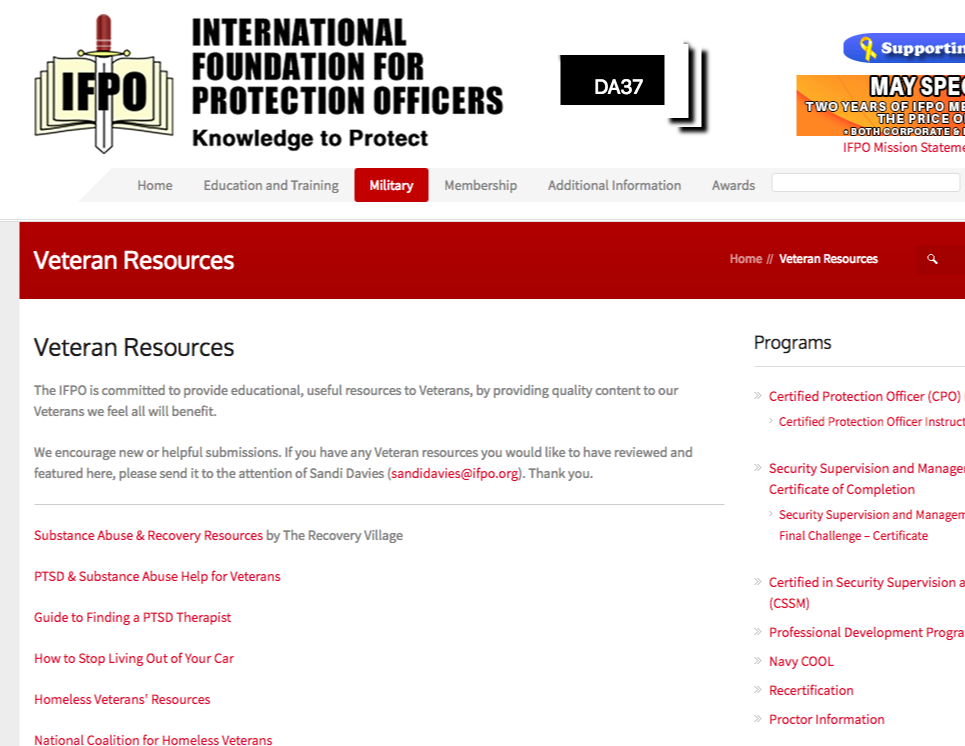

At SharpRocket, we've found that websites/blogs with lower metrics can be of highly useful for future campaigns. Some less authoritative websites can increase their organic traffic and earn/build links over time, which will eventually improve their entire domain authority.
Capitalize future equities of those neglected websites by making a separate list or spreadsheet to include them.
This is an approach not to run of our link prospects as you can return to your list over and over again, and find new ones that have improved its domain authority (or have passed to your benchmark metrics).
6. EXCHANGE CONTACTS WITH ACTIVE GUEST BLOGGERS
Building relationships with industry bloggers is vital not only when pitching them to become a guest contributor for their publications, but also in expanding your own list of link opportunities.
One approach that you can maximize in this situation is to pass on your contacts with them. Share your own lists of blogs that you have pursued for content contributions.
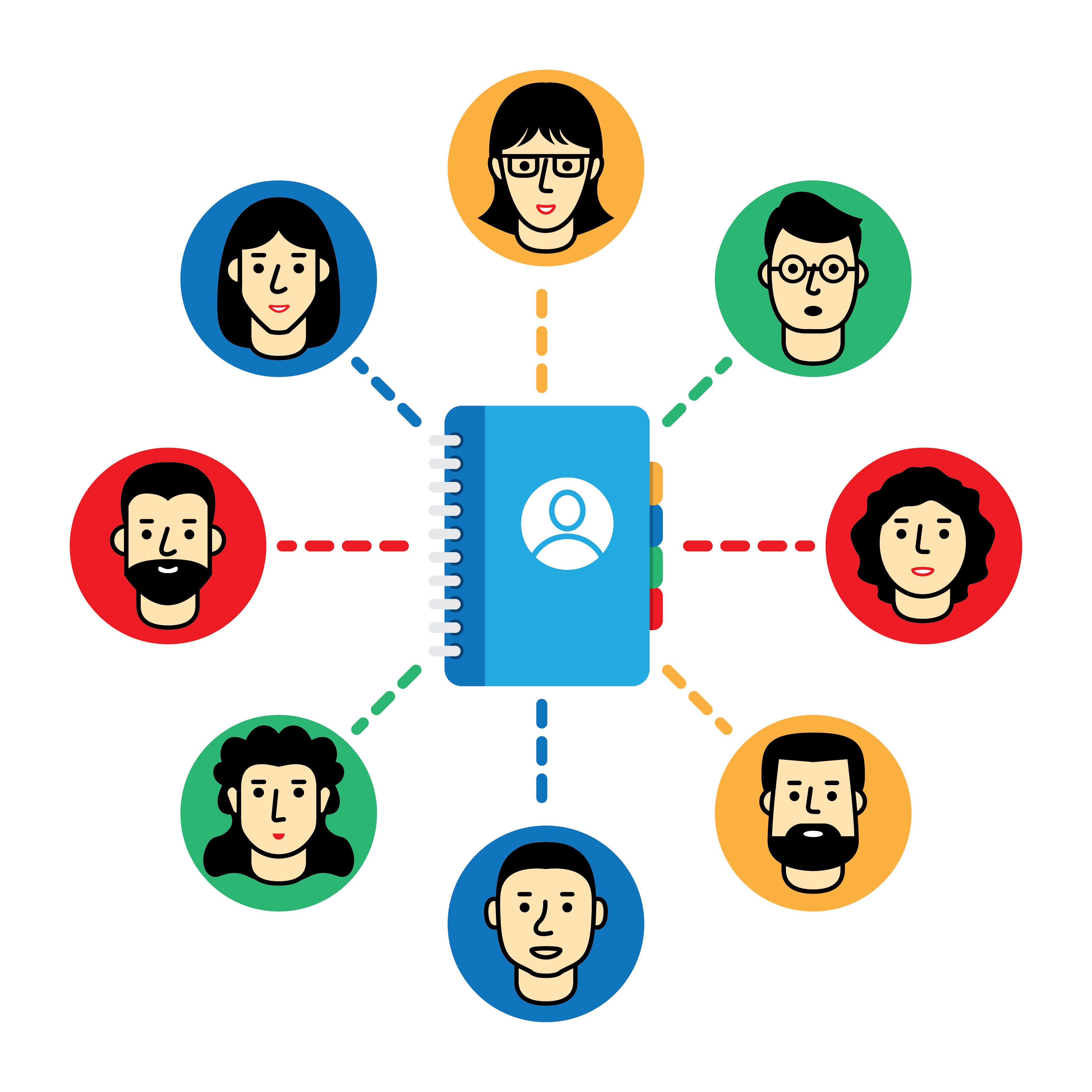

7. REVERSE ENGINEER BROKEN PAGES FOR MORE LINK OPPORTUNITIES
A huge number of broken links on the web is the main backbone of broken link building.
Finding defunct links on a resource page and showing them to webmasters is one way to initiate conversations and eventually acquire links by suggesting link replacements (wherein one of the links is a link to the client's content piece).
The process ultimately starts with prospecting for relevant resource pages.
One prospecting methodology besides doing a Google search for common resource page queries - inurl:resources "topic;; inurl:links "topic" is finding other resource pages that are linking to broken links.
Start this process by finding broken URLs, which can be defunct links you've initially corrected in your first set of prospects (resource pages).
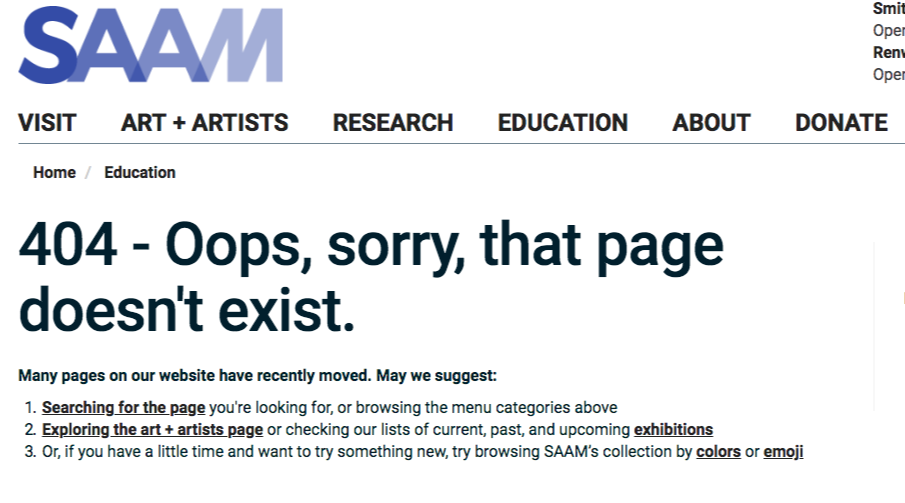



Create a spreadsheet to collect all websites linking to broken pages.
If you've found 20 broken links and have checked that there are around 300 total pages linking to them, your initial list has now grown to additional 300 prospects.
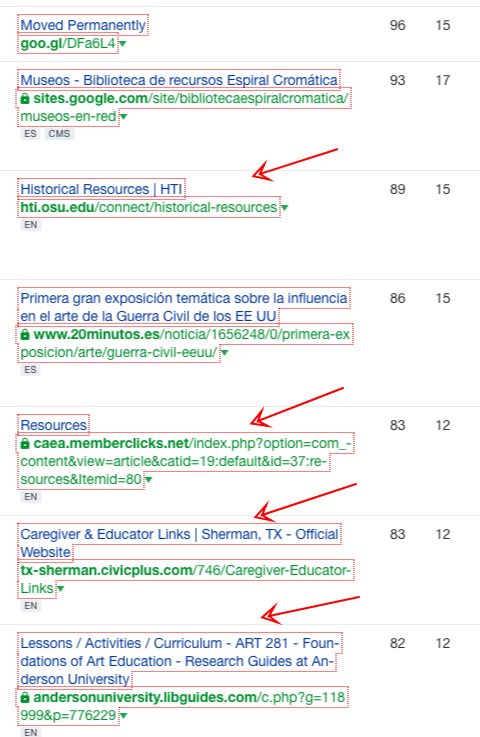

Of course, you have to quality these additional link targets by relevance, authority, and obtainability.
But overall, the said link prospecting (reverse engineering) methodology gives you room for more link opportunities.
8. CREATE NEW LISTS FOR NON-INTENDED AUDIENCES
One common mistake I've seen link builders do when prospecting link opportunities, specifically for resource pages, is ignoring current pages on their tabs as soon as they quickly find that these pages do not pass certain links' standards (e.g. irrelevant to their intended audience).
This tip is almost similar to the above prospecting principle (save prospects of lower metrics).
However, what I'd like to highlight in this last prospecting tip is saving prospects of different intended audience.
When you've landed on a page and found out that it's not relevant to your audience-targeting, you basically ignore it and move on to your next link prospect.
What I personally see a lot of value in seeking for more link opportunities (and for content generation, in general) is creating a new tab/list of other pages that don't fit to my current intended audience.
For example, when I'm looking for parenting-targeted resource pages and have come across pages that are targeted to non-intended audiences like LGBTQ, mental health enthusiasts, persons suffering from trauma, stress, and attempting suicide - I make new lists to collect them all.
This can somehow make it easier to find new audiences to target for future content assets.
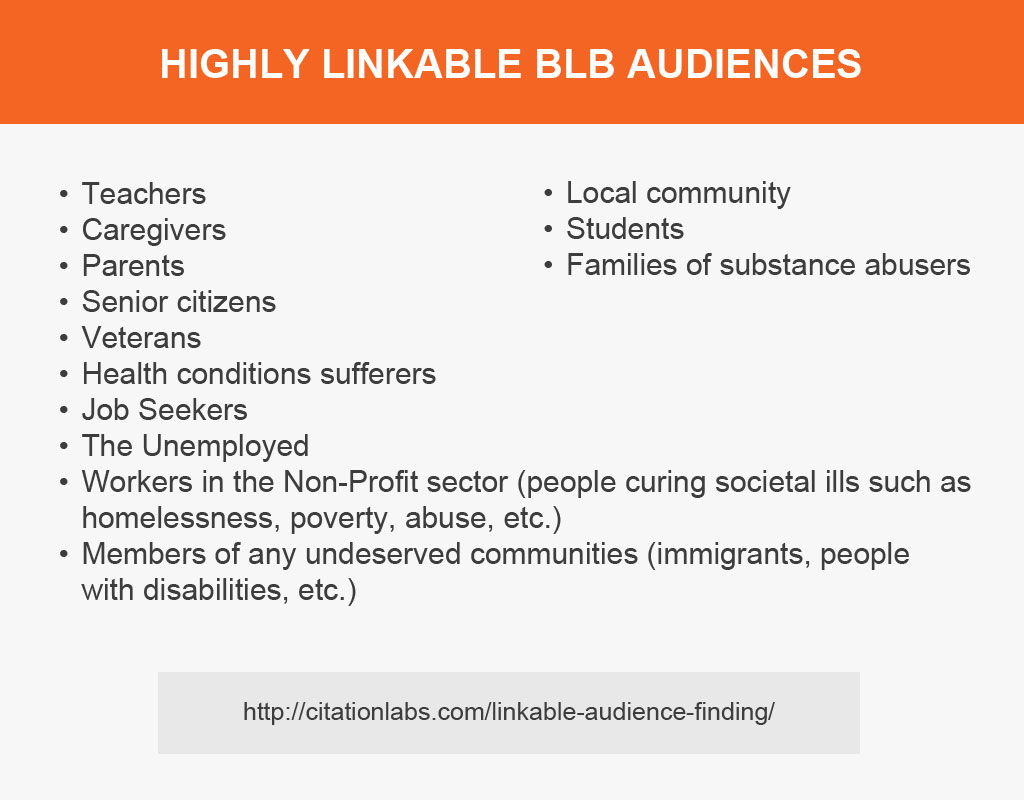

If you’re just starting in audience-first link building campaigns, you can start off with Garrett French's 601 Audience spreadsheet and basic linkable audiences as a base - and add more on to it along the way.
Liked this post? Subscribe to our newsletter and follow me on Twitter @venchito14.
4 Advanced Link Prospecting Techniques for Increased Efficiency
As I've come across several resource prospecting campaigns, I always notice little things that makes part of it more efficient. Efficient prospecting means producing a highly targeted output with the less amount of consumed resources (labor, time and cost of tools).
That itself requires experience through observation. So, here are four advanced prospecting techniques that hopefully can improve efficiency of your campaigns and help expand your list of link opportunities.
Table of Contents
1. WEBSITE CATEGORIZATION
When starting a new outreach campaign for a client, the first initiative is to scour new link opportunities on the web from scratch. While this is good if it's a new industry you're taking on, isn't it wise to go back first to your previous list of industry-relevant opportunities and check which ones could be reuse for the new campaign?
Not only does it save time, it also saves a lot of labor consumption prospecting for links.
Website categorization does help with this. By using tags, you'll be able to categorize prospects from a topical perspective.
What you need here is a defined hierarchy of topics to begin with. For me, I recommend BOTW as starting point, given that they have four or five deeper-level topics such as Pro-Choice Abortion (Society) and Eating Disorders (Fitness) which is extremely important if you've got clients from a very-specific niche.
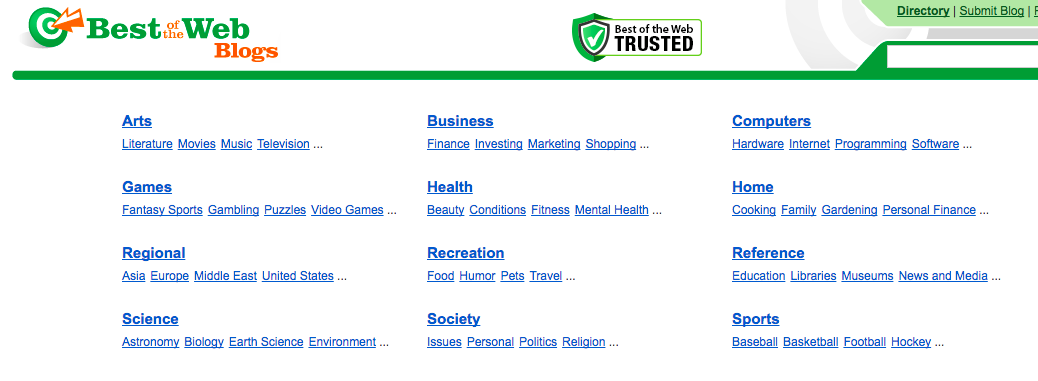

The next time you need automobile blogs, you can pull them off from a list within a few minutes.
2. CHECK DESCRIPTIONS IN LINKS TO EYE SEO'Y CONTENT
Backlink research is the process of identifying current and potential competitors and getting pages/sites that linked to them for link opportunities.
SEOs normally identify these competitors through Google search by checking which pages are currently ranking for target keywords or creating a list of competitors' sites coming from clients themselves (as they already have ideas which brands to compete with).
While these two approaches are best practices to find your most relevant competitors, you may still miss out some SEO'y content (as what Ross Hudgens coined it) that you should reverse engineer on.
SEO'y content are pages or content pieces already linked out from a resource page you're trying to reach out to, that have earned tons of links from several linking root domains.
Looking for SEO'y content can expand your vertical prospecting, either from a horizontal or vertical perspective, as they aren't easily found through Google search or normal prospecting.
One way to identify these SEO'y content is to check discrepancies in description of links. What I mean with discrepancies is that there are resource pages with full descriptions for each link and there are some with links with unusual descriptions.
I got this idea when I received a response from a webmaster putting a link to our client's page from their resource page.


If you skimmed the email above, you'll notice that there's nothing uncommon with the email, only does it implies that the webmaster is in a hurry not to include a description for our link - the reason she requested if we can create one for them.
Discrepancies in link descriptions—either the description is not complete or not in format with other link descriptions (see image below)—are signs that the resource page had recently given a link to an SEO'y content. TigerMobiles.com and US Dish links have Titles as their descriptions while other links have longer texts that describe what those pages are about.
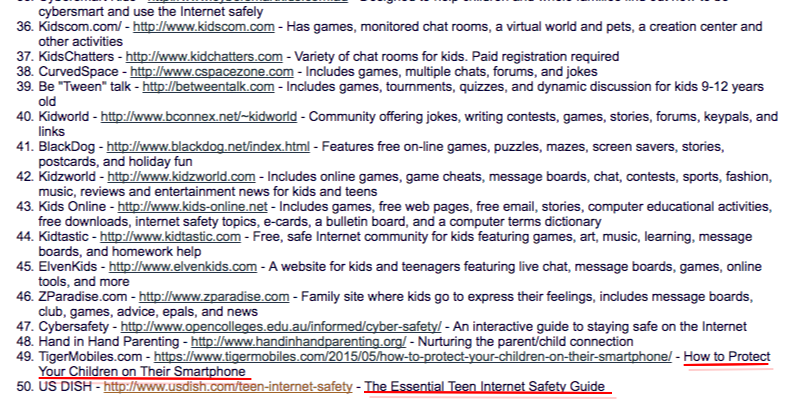

It means that these SEO'y content are actively pursuing relevant link opportunities (primarily resource pages) in the same manner that you do. If you could scour their existing links (some may have been recently just acquired), it will help you gain link targets that are receptive to content suggestions. Thus, giving you higher link acquisition rate in your outreach campaign.
Clicking on SEO'y content links and assessing if they have relevant links you can potentially use as link opportunities is a great activity you can add to your link prospecting process.
The best way I recommend to initially check if these SEO'y content has good number of linking root domains is to run them through LinkMiner.
The tool checks all external links on the resource page and highlights how many domains are linking to a certain external page.
3. USE LINKCLUMP TO UNOPEN DOCUMENT LINKS
In link prospecting, the more you spend time checking for unnecessary links, the more you waste time that should've been otherwise spent pursuing for the right link opportunities.
What I've noticed with newbie link builders is that they often click on document links (pdfs, words/spreadsheets ready to download, etc..) that are consuming seconds (if not minutes of their time) which are all useless if your main targets are links or resource pages.
The recommended approach is to use a tool that'll automatically unclick these document links once you start qualifying your list of link targets.
For example, if you have a list of pages ready to be qualified for certain metrics (DA, relevance, obtainability), copy and paste them in an opened tab tool (e.g. URLOpener.com).
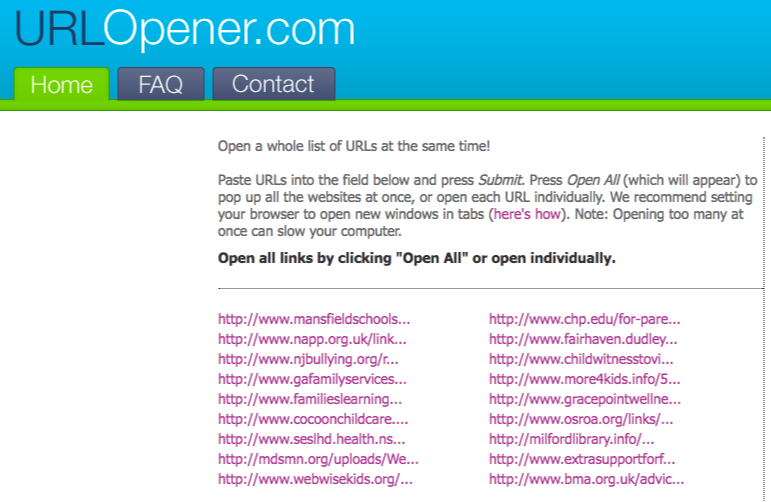

Once you right click and drag external links from URLOpener, the action itself won't open document links as new tabs given that you excluded certain words in the tool's setting.
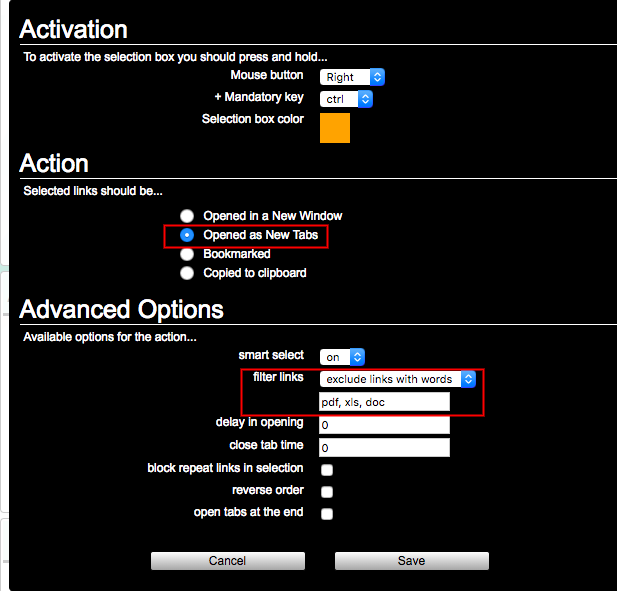
4. UTILIZE NICHE PHRASES TO EXPAND LINK LIST
If you are familiar with your industry, it's easy for you to know what phrases are commonly used as titles in resource pages. For example, in the transportation industry, you'll see a lot of "getting there" pages. These are phrases that are only specific and be applied to a certain vertical.
But one question that may arise here is, what if it's a new niche I'm taking on, how can I identify niche phrases I can use for expanding my prospecting approach?
The best way to do that is to collect the titles of your first set of resource pages (I'd recommend that you get 80 or 100 links pages from your list for optimal results).
Use Wordcloud to see common niche phrases.
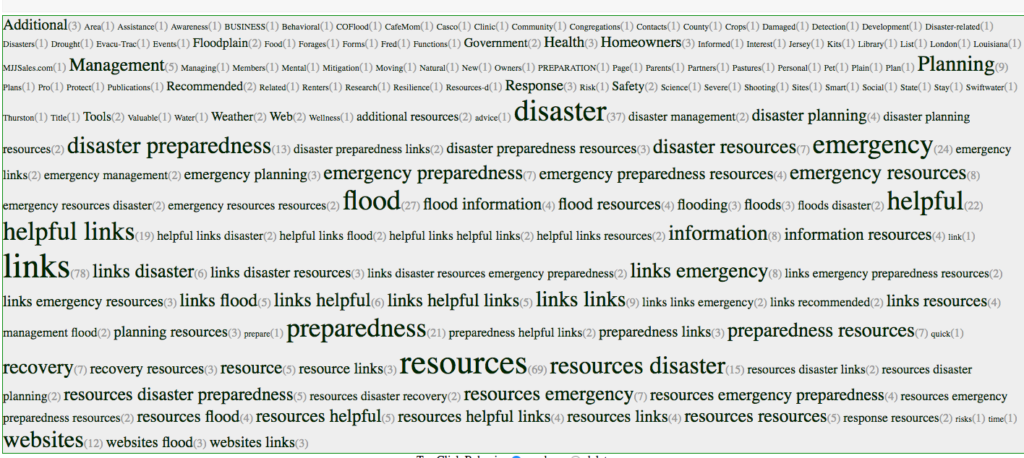

Ensure that you click phrases only and display frequencies checkbox. Phrases only feature does what you need from tool - to give exact niche phrases while display frequency shows you the number of times a phrase appeared in the list.


If you are clever enough about using niche phrases, your list of link opportunities will expand.
Other Useful Resources:
- 4 Reasons Why You Don't Get Resource Links
- How to Identify and Pursue Linkerati
- How to FuturePoof Your Links By Determining Lifetime Link Value
If you liked this post, subscribe to our newsletter and follow me on @venchito14.
Need help with your link building campaigns? Check out our link building services here.
4 Reasons Why You Don't Get Resource Links
Every pitch receives a yes or a no. In resource outreach (more often known as broken link building), a "no" isn't a direct response of "no". Instead, a "no" is a reason of so many reasons why a webmaster or the person managing the page couldn't give your desired resource link.
Table of Contents
1. NOT CURRENTLY UPDATING THE PAGE


No matter how good the content is, if the page you're pitching to isn't currently open to any link updates, you won't be able to get the link.
So instead of crafting a lengthy email to describe your guide, try sending a short pitch first to ask if they're open for new link suggestions. An email may look something like this:
Just saw your note on your online job hunting page about new suggestions, so thought I’d check and see if you’re still updating the page. If you are, I'm happy to pass along a few new resources for review. If not, can’t say I didn’t ask!
The reason this is important is because you're starting a small conversation first, not taking advantage immediately of the link opportunity with a heavy pitch. You respect the person's time by asking if he or she considers resource suggestions, thus, you come off as less aggressive.
The sooner you get a "Yes" response from this approach, that's the time you can now describe how your content can best fit their links page and their audience.
2. REQUEST OVERLOAD AND SUFFICIENT RESOURCES
With so many SEOs building links to their sites/clients using the same link building strategy (broken link building), it's highly possible that a resource page is getting pitched almost every single day.
Take a look at these emails we've got:
(Request Overload)




Obviously there are hundreds, if not thousands, of webmasters receiving similar messages like the one above. It's a reality that you're not the only person pursuing for the same link opportunity. A competition among SEOs/link builders gunning for the same link prize is considered to be a problem, but can also be an opportunity.
If you consider this dilemma problem upfront, you can give yourself an opportunity to ask yourself questions regarding your content before actually pitching them to your link prospects.
One question you can ask is, "Does the content I'm suggesting have competing/similar content pieces on the links page?". What I mean with competing is if you have a "resume templates" guide, does the links page have resume links too? If you cater to both niche audience with the same information, but don't necessarily mean you're competing for the same keywords, that particular content piece is your content competitor.
You may as well check what keywords in URLs those resume links are trying to rank for. If they target the same as your content piece, it may also be considered as your competing content.
Two reasons why you need to check for competing content assets:
A. Know if your content asset fits a subtopic/sub-section of the links page.
This is a good idea because you know that there's a reason for the webmaster to insert a link to your page, as it fits into a category. It's less likely that a webmaster will create another section of the page to just give you the link if in case your content piece doesn't fit to any section.
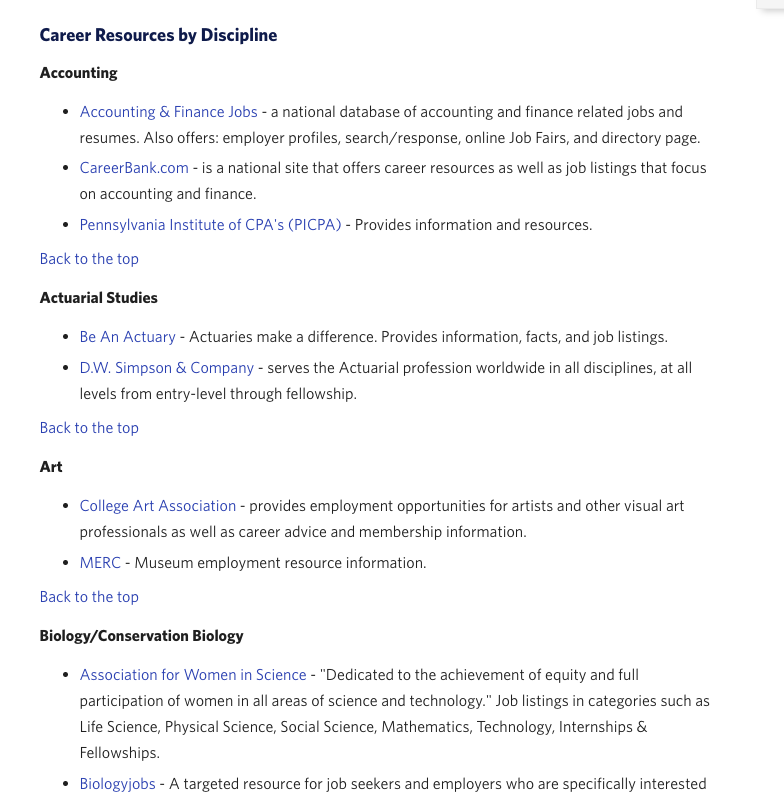
B. Check if you can fill an informational gap.
To fill an informational gap, you can either create a better version of the content than anyone else (10x content) or provide a unique value (either in format/angle of the topic).
Place yourself in the webmaster's shoes. Ask yourself, why do I need to add the suggested resource on my links page considering there are two or three resource links covering the topic already?.
This question sets the bar of your content's quality - increasing your chances to get
For overload requests, the difference-maker in getting the resource link is your content's comprehensiveness and utility that fills in the gap in the category/information of the resource page.
3. NO CURRENT PERSONNEL TO ADDRESS


It's frustrating to know that the reason you don't get the resource link is not because your content sucks, but there's nobody currently taking care of the resource page.
While there are some high-authority websites with ready-correct department - a group of people who ensures every resource link is reviewed to pass certain standards before they actually go live, there are a lot of other links pages with no current personnel handling them.
We've found that one way to ensure you're not missing those link opportunities is to mark the resource page or create a new tab that includes all of the link opportunities with no current personal addressing them. Then you can set a schedule time to follow up these links after two months.
You've done a lot of work to prospect the opportunity and write an outreach email, so it's a failure to get the potential equity it'd have been developed if you didn't follow up the person.
4. SOON TO DEATH RESOURCE PAGE


It's easy to jump off to another link opportunity when your target links page is going to be killed either because it's of no use to the webmaster or the department/personnel is not updating it anymore.
It happens, but there's a chance they might be creating a new links page with the same topic.
I recommend sending a follow up after a month, asking if they have a new resource page your content might be a good fit is a less work but can gain a return in outreach.
Other Useful Resources
So, those are the four reasons why you don't get resource links and tips on how to pre-solve those problems.
If you liked this post, subscribe to our newsletter and follow me on @venchito14.
Need help with your link building campaigns? Check out our link building services here.
4 Scalable Link Building Tips
For the past few years, the debate about quality versus quantity in link building has been subsiding as more SEOs and business owners have gained a deeper understanding that it's the quality of links that matters over quantity.
Given that, some link builders still find it difficult to consistently acquire relevant links on a monthly basis.
But it's certainly possible with the right approach and improvements in processes to provide solid high-quantitative link reports.
Agencies like Citation Labs, based on their 2015 slide presentation, can accommodate a total of 300 resource backlinks every month to their clients.
Our team at SharpRocket is able to supply links ranging from 6 to 30 in volume to each client on a monthly basis.
It may not be a big number to most readers, but using sweat-and-blood approaches in link building, it's the highest quantity that you can achieve with a handful of resources you have.
Scalable link building requires speeding up phases in the area of link qualification, link prospecting and targeted outreach. Subtle changes that you can make to each phase can tremendously impact your campaign's efficiency.
For the past several months, we've noticed and tested a few approaches that if done well, can create success for your next link building campaign.
Table of Contents
1. SOURCING MICRO AND MARCO CONTENT FROM INDUSTRY INFLUENCERS
Content creation for external distribution (or guest blogging) is easy to scale if you've got a team of in-house writers or outsourced freelance writers to accommodate your content writing needs.
However, if you're in scarcity of resources, one approach that you can use to facilitate guest blogging is by interviewing industry influencers and using their Q&A content as external assets for distribution.
Initially we start sending outreach emails to productivity publishers who might be interested to accept any of these two content formats:
- "How-to" [ topic ] interview content
- Guest post on [ topic ] (that includes a few insights from productivity experts)
The key to make this pitch standout is to highlight that you'll be including insights from industry experts in your guest article. Given that publishers would normally ask for high-quality guest posts (as we always request for outside contributors for our blogs), the approach of emphasizing the credibility and value of your content up-front can improve your chances of getting a response and eventually increase your closing rate.
Then you can throw-in topics of content that they can choose from.


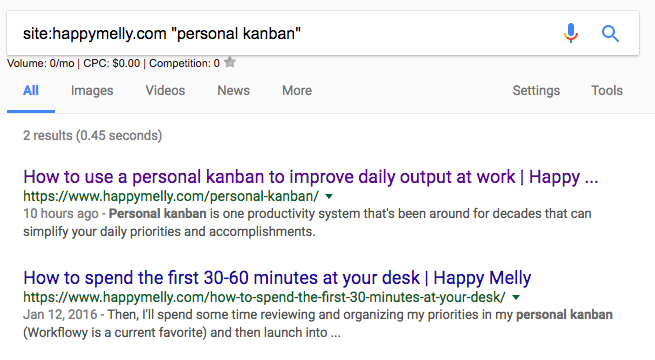

Further reading: How to Improve Your Link Outreach Success Rate
When they've chosen a topic to write about, it's time to create the content.
There are two ways on how you can approach content creation: create content with validated insights from influencers or use Q&A content with an influencer and format it as an external asset.
A. Validation To Your Insights
Instead of providing one generic round-up question to your target influencers and compiling them into one big post (just like what you normally read see in most round-up posts), you can ask influencers for insights to questions being discussed in your article draft.
Statements from influencers can serve as a validation to your article points that adds credibility to the overall content.
As an example of this approach, we've looked for productivity bloggers/experts to get their expert opinions on different subjects of productivity.
In my earlier example, the topic that the publisher wanted us to write is "personal kanban" - a personal productivity system.
We had to look for industry bloggers who have personally experienced using such productivity tool in their professional lives.
To speed up the entire blog prospecting process, we chose an authority website that has outside content contributors and that interviews niche influencers on its podcast show (these influencers/contributors were then our target prospects for interviews).
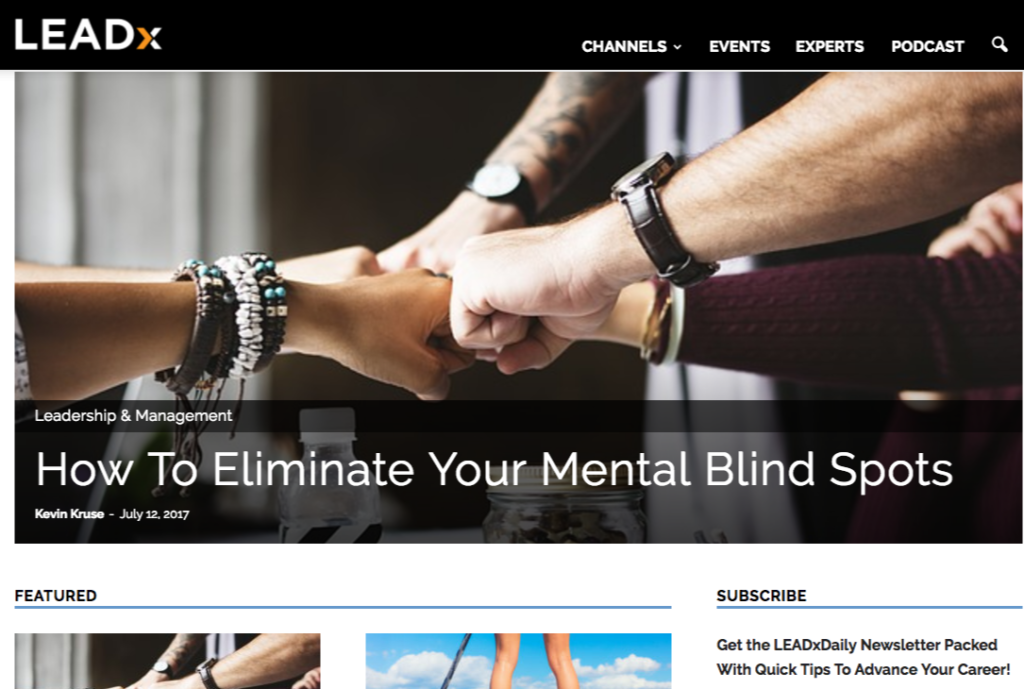

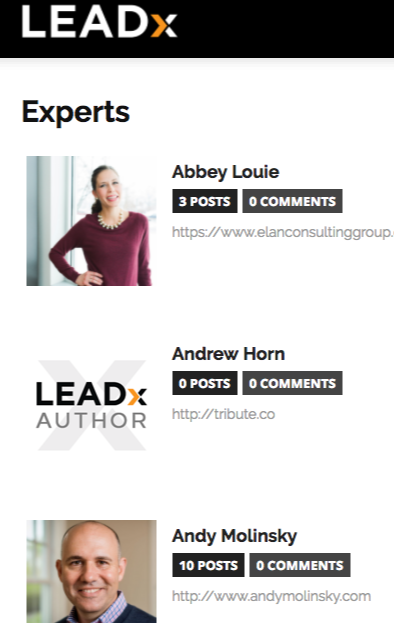

Using URL Profiler to scrape data from author and podcast pages, we've managed to create a list of 20 industry influencers (who are past and current contributors of LEADx.org's blog section and who became guests in their podcast show).
You can also do this process manually, if you're not a subscriber of URL Profiler.
In estimate, the manual approach will only take you 25 to 30 minutes.
Your next step is to gather contact details of your target interviewees to prepare for the outreach campaign.
As for the outreach, it's important to ensure that your authority bloggers will also benefit from the content partnership you're proposing. Reciprocation in a form of getting a link on a guest post written on a top-notch industry blog can increase the chances of getting positive responses from them.
Here's the exact email template we used for this kind of outreach:
Short interview with you [Name]
Hi [Name],
I'm [Your Name], a blogger and productivity enthusiast. I've found you on one of the podcast episodes of Kevin Kruse at LEADx.org and learned great insights from your conversation with Kevin.
I'm fascinated and wanted to conduct a short interview with you. I'll ask a few questions, compile your answers and use it as a guest content for a top-notch productivity site (not mine).
I greatly appreciate your response in advance.
Thanks,
- [Your Name]
From 20 authority bloggers we pitched for interviews, we managed to get 14 positive responses.
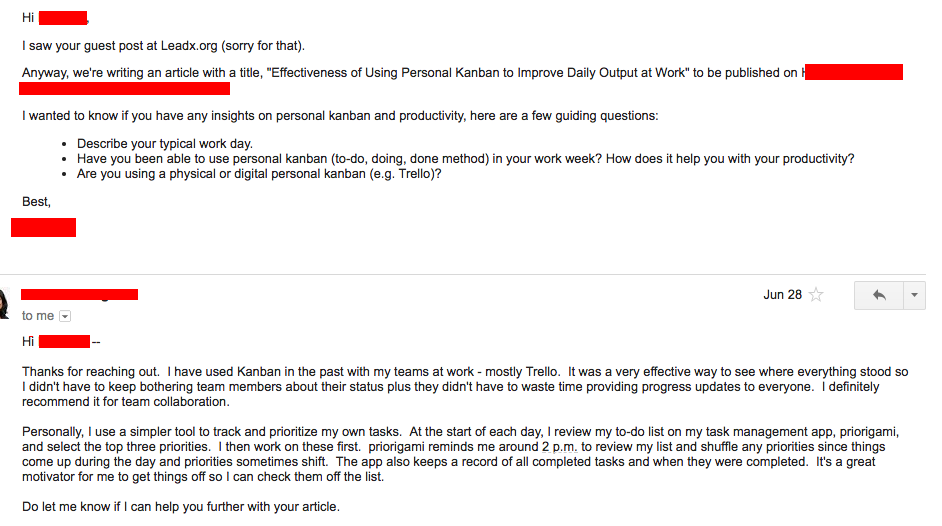

Here are some takeaways why the outreach campaign worked:
- Used prospects' name and their websites' name.
- Included the source where we've found them (I've found you one on of the podcast episodes …) - helps strikes a more personal approach on the email.
- Stated the value proposition to easily catch the interest of the outreach prospect (use it as a guest content for a top-notch productivity site). It helps secure confidence that their answers to questions can reach more audience.
- Straightforward subject line to get the message across.
You may want to check out this guide on blogger outreach to get more tips on how to effectively craft email copies specifically for blogger outreach campaigns.
Finally, you have to submit your finished content with great insights from niche influencers for content approval.
Then, acquire links:
A link to the influencer's website (for his contribution):
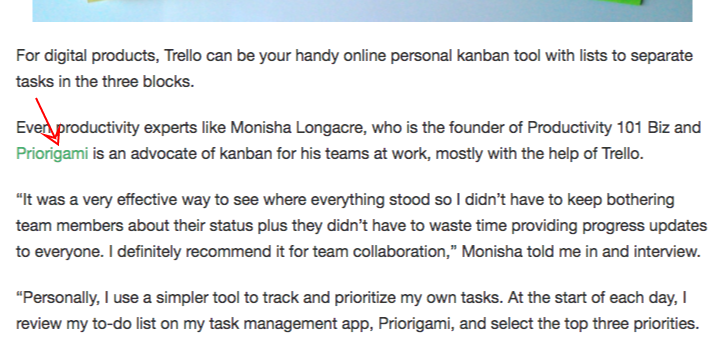


B. How-to Interview Content
There is another way to maximize interview content besides using it as a validation to your article points - that is, utilizing the entire Q&A content as your guest post.
It is best to format it as a "how-to" article rather than just compiling expert's answers into a Q&A format and submit it directly to your target publisher.
You also have to structure the content in a way that is easy to scan and read, and that emphasizes the "specific topic" you're discussing about.
So the title can be something like, "How to [Topic] with [Influencer's Name]".
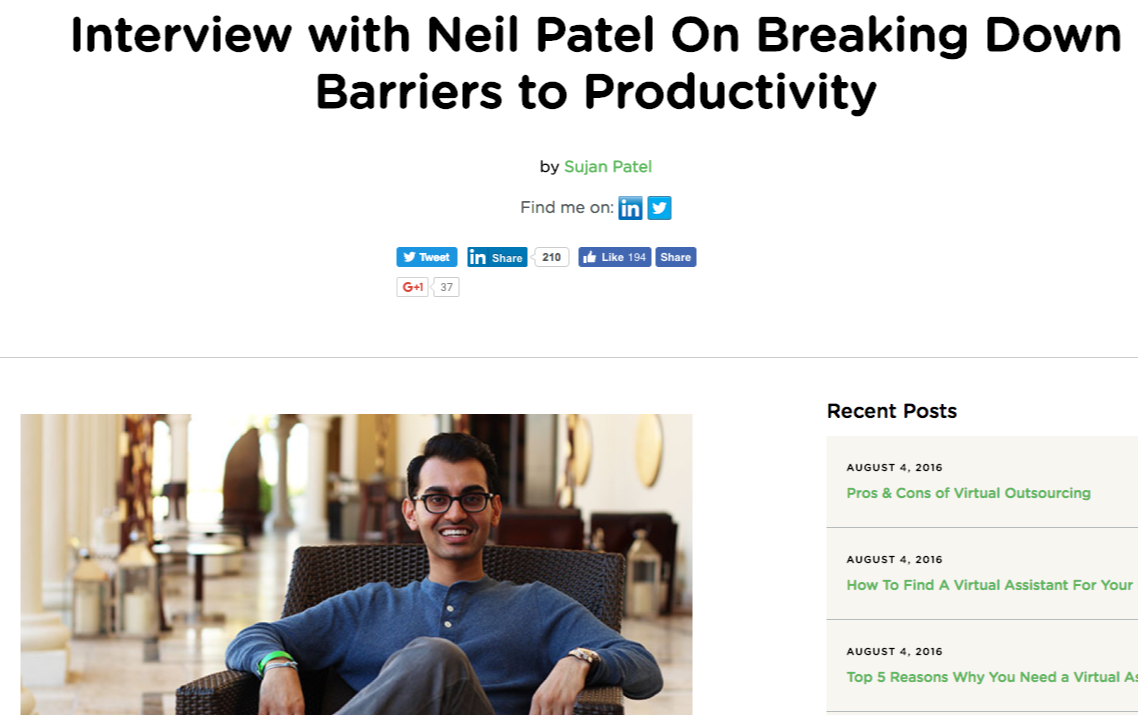
2. SCALE BLB PROSPECTING WITH CITATION LABS
For the past several months, I've been using Citation Labs heavily to scale prospecting for resources pages (or links pages) for our broken link building projects.
Disclaimer: I'm not an affiliate marketer of this tool.
Given that broken link building requires tedious work on prospecting especially if you're working on several BLB campaigns, using a tool to prospect thousands of relevant link opportunities is definitely a big help.
Using Citation Labs for a broken link building campaign, we've managed to create a list of 22,000+ job and career-specific link prospects with Domain Authority of 40 and above.
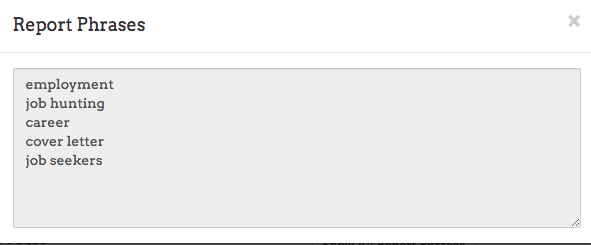

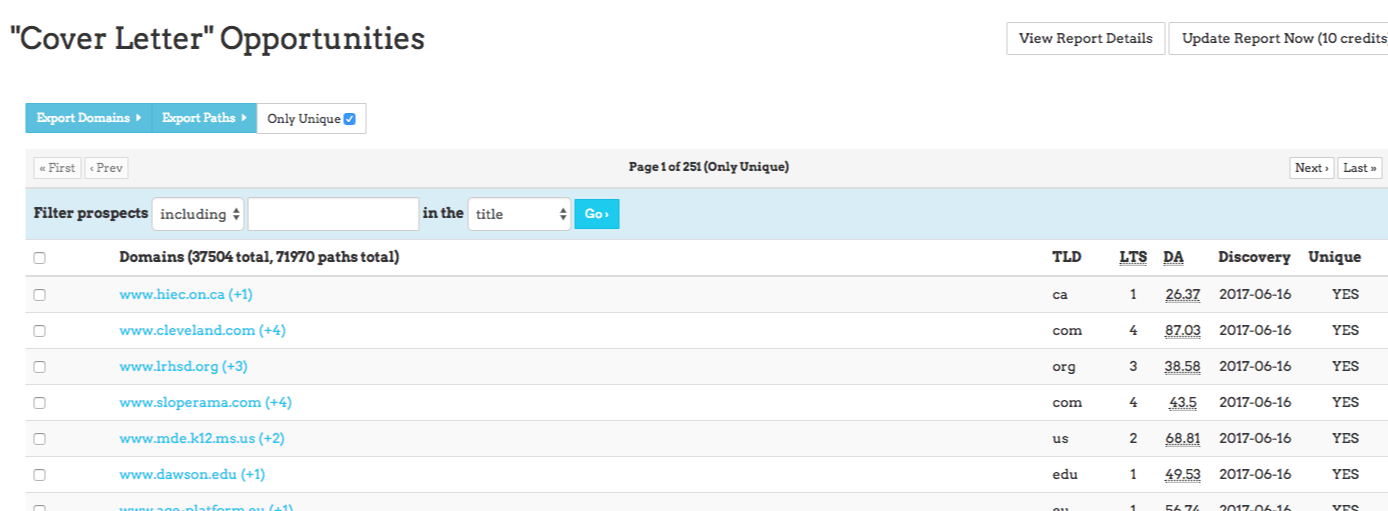

The list is further qualified to pass the relevance test, which resulted to 400 targeted prospects out of the first 10,000+ unqualified pages (4% qualification rate).
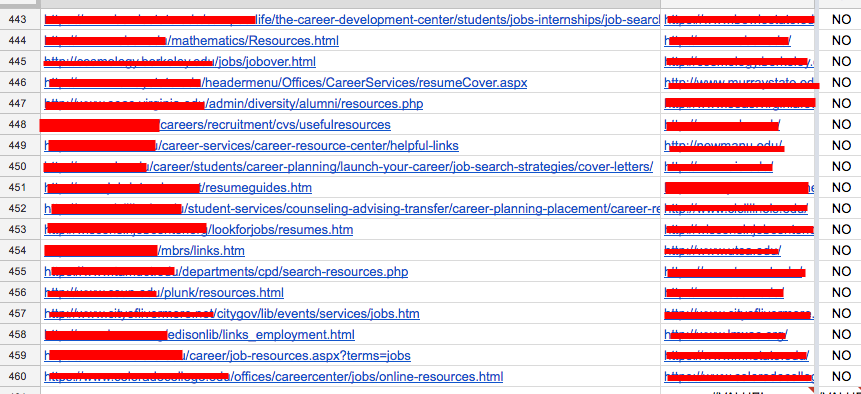

On average, we can qualify 1000 prospects based on relevance within 15 to 25 minutes. So the total time it took us to conduct relevance test for 10,000 pages was 2 1/2 hours to 5 hours.
Assuming you have a newbie link builder and he manually searches for link opportunities, it'd probably take him 3 to 4 hours to find 30 to 40 links pages qualified based on relevance and certain metrics like Domain Authority.
So for 400 qualified prospects, he would consume 40 hours equivalent to 1 week of work.
Notable advantages of utilizing Citation Labs for bulk link prospecting are:
- Improved efficiency in prospecting - as it requires less hours to manually prospect for link opportunities, so time can be spent on qualifying link targets based on relevance and obtainability.
- Expand link lists for untapped link opportunities - pages discovered by the tool aren't necessarily ranking for linker-based queries (inurl:resources "topic").
Besides searching for links pages, Citation Labs can also help link builders to find other type of link opportunities such as review pages, forums and professional organization sites.
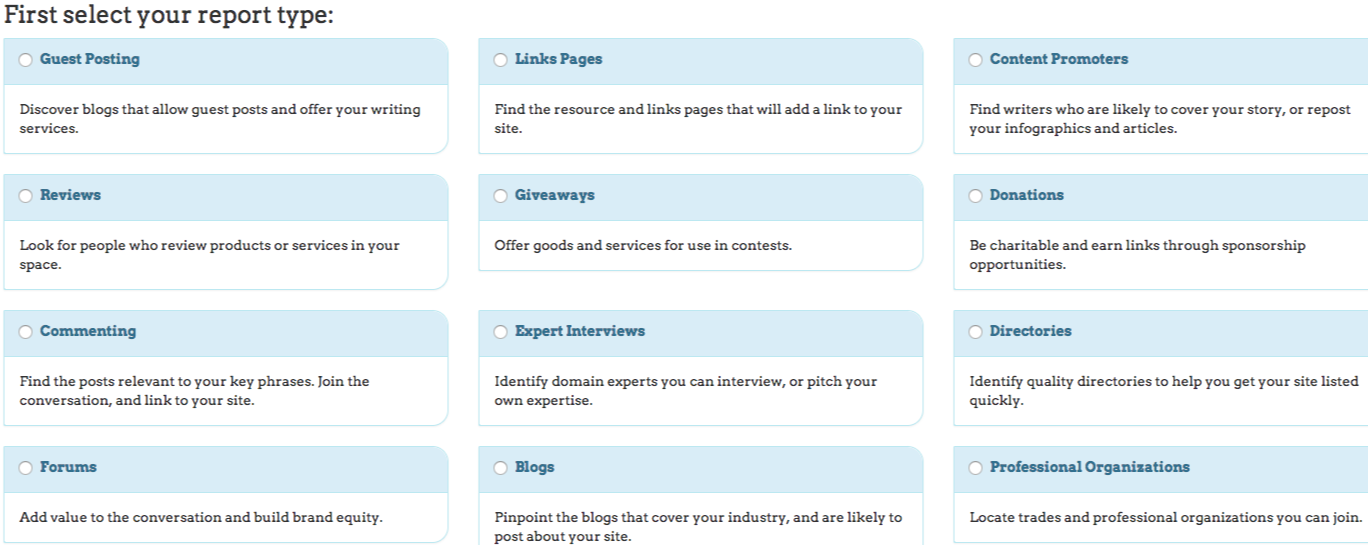

3. HIRE VIRTUAL ASSISTANTS FOR MENIAL TASKS
Apparently, outsourcing is a cost-effective strategy that can improve your link building campaign's efficiency. By giving menial tasks to freelancers, it helps you allocate more time on other important activities, which can help elevate individual and team's output and productivity.
Basically, the tasks that you'll be outsourcing are ones that'll only require basic knowledge and skills and can somehow be executed right away even without much deeper training.
Here are a few examples of link building tasks you can outsource to:
- Contact finding (name, email address, contact forms and social profiles - if email address is not available).
- Finding important page or site-level details (page tilte, article title)
- Initial pitching (sending your outreach emails using an email template with only a few tags to replace details with)
As an example, we recently started hiring virtual assistants locally (freelancers who are based here in the Philippines) and from other countries like Bulgaria to help us with bulk link building activities.
Instead of posting online jobs to facilitate hiring, we use Linkedin as a platform to manually search for freelancers who had previously worked for a similar company (either a full SEO service agency or a link building company).
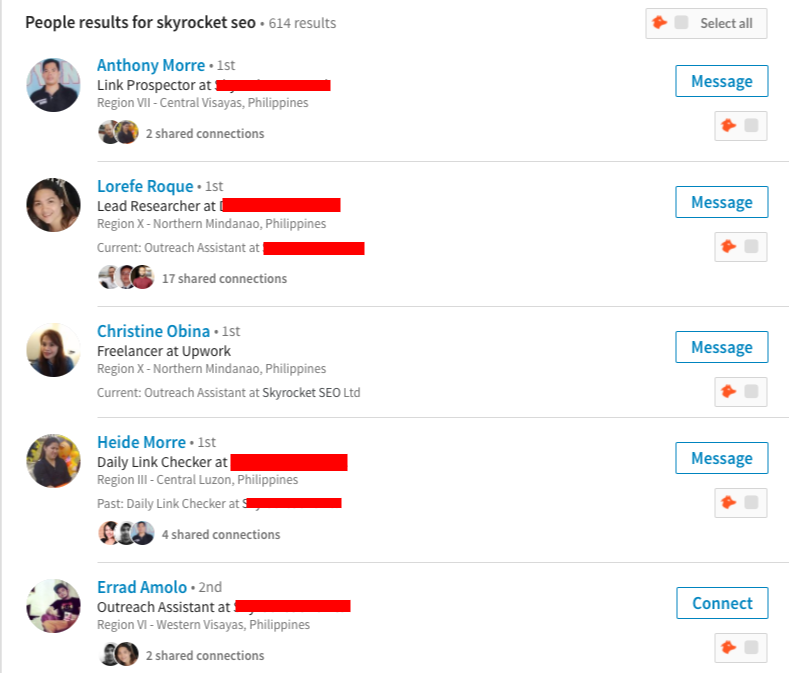

The advantage of doing so is we were able to hire freelancers who can deliver more output than someone who just undergo a training process.
We also checked their work histories if they handled previous link building campaigns or any associated tasks like contact finding and daily checking of emails.
Before jumping straight to outsourcing, we created simple step-by-step documents that walks them through the entire process of executing the task to avoid recurring questions we'll then received from them, as they work on each campaign.
We use GDocs to easily share documents to our freelancers.
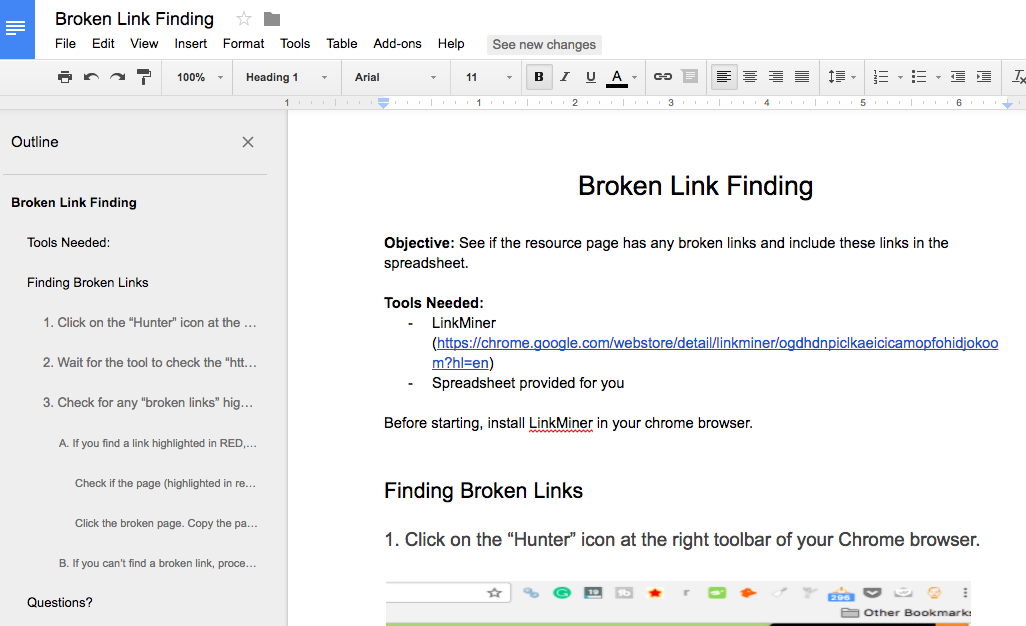

This outsourcing approach can certainly improve your campaign's efficiency with the right people and processes.
Further reading on outsourcing:
4. PERSONALIZED EMAIL MERGE
As quoted by Jason Acidre on his SEO blog, "Outreach is probably the most tedious component of our marketing discipline because the activity primarily intends to build relationships."
I couldn't agree more with this statement, as we've done hundreds of outreach campaigns and to only succeed is to put the hardest work in creating the best offer (value prop in emails), in prospecting for highly targeted publishers and in sending email copies that'll mutually benefit both parties.
There's one subtle approach we've tested to improve the efficiency of our outreach campaigns - that is using a personalized email merge tool.
We initially start by installing Yet Another Email Merge to Google Spreadsheet as an add-on tool. It allows us to send 50 emails in every outreach account for free (there's a premium price if you're sending 400 emails a day).
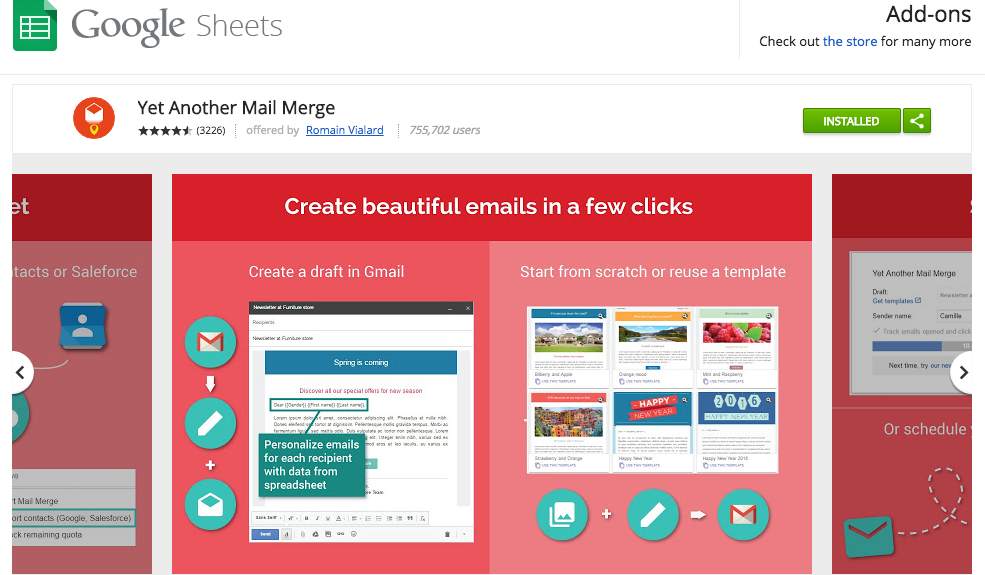

Unlike the typical mail merge system that blast off email spams to publishers, this email merge tool allows us to personalize email copies while semi-automating sending off emails and scheduling them at the right time when prospects will likely to open.
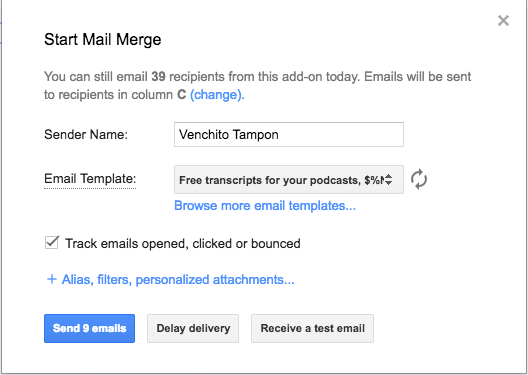

Note: When using this approach, it's extremely important to set intervals in outreach, not to trigger Gmail from spamming your account. Instead of sending 400 emails one-time off, you can divide them into 5 or 7 days with intervals if possible, and just send 40 emails a day.
Here are a few advantages that this tool can bring to your outreach campaign:
- Enables scheduling features for different timezones.
- Tracks open and response rates as well as how many emails were sent and bounced back (or had errors in sending).
- Failed messages (bounced back emails or emails with technical errors) can be replaced immediately with secondary emails which streamlines your follow-up or second-pitch processes.
- One-click away from Google spreadsheet to schedule emails.
![]()
![]()
The said outreach tool requires a draft email which serves as your outreach copy to send or schedule emails. Using tags ($/Name/$) in your draft email is important to extract data from your spreadsheet and produce personalize emails.
This outreach approach can benefit you in so many ways, such as:
Initial-pitching using successful outreach copies
If you've tested a couple of outreach templates and one of them has successfully earned the highest open, response and closing rates (or even just the highest closing rate), you can use your most effective outreach template as your email copy in Yet Another Email Merge function for your next outreach campaign.
Follow-Ups
It would be more efficient to send short and straightforward follow-up emails using Yet Another Email Merge tool, which only takes 10 to 20 minutes to complete, than manually sending/scheduling all follow-up emails using your outreach accounts.
![]()
![]()
Considerations When Using Yet Another Email Merge
As you get your hands on to this tool, you may experience a few mishaps that can be avoided if you've taken a note of them.
Semantic Breaks
Ross Hudgens discussed semantic breaks in his outreach best practices post that should be noted carefully if you want to secure positive responses in your outreach campaigns.
A good example of this is when you send an email to a person with a tag, "I saw your post on venchitotampon.com blog" and you're addressing it to the blogger himself, "Venchito Tampon". A normal person would rather say, "on your personal blog" instead of naming the whole domain.
When you start using the tool, you might create a column for Website/Blog Titles that includes all branded names of your target link sources.
If not carefully checked, you might put the whole domain (venchitotampon.com) instead of inserting "personal blog" or "personal website".
Leaving off blanks
The tool requires you to create columns for Names, Email Address and other tags such as, Blog Name and Asset Title to further personalize your email copies.
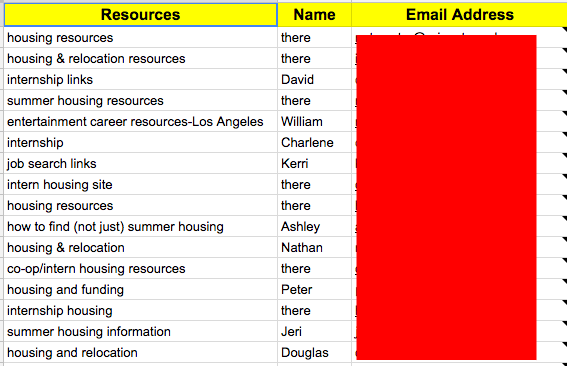

All columns should be filled out with necessary input. Otherwise, you might see an email sent that sounds like a spammy build blast.
My trick here is to input the word "there" to blank cells in the "Names" column for email addresses with no available and visible names.
The final email copy will look like this:


If you liked this post, subscribe to our newsletter and follow me on @venchito14.
How to FuturePoof Your Links By Determining Lifetime Link Value
As defined by Wikipedia, life-time value (LTV) is a prediction of the net profit attributed to the entire future relationship with a customer.
This business concept enables entrepreneurs and marketers assess payback of advertising spent in promoting a product/service.
Replicating this same principle to link building campaigns can enable us to future proof links by considering their long-term effect on the pages they’ve linked to.
What is lifetime link value?
Lifetime link value is a self-evaluated prediction of the entire value of a backlink target to assess its potential impact to its destination pages. (coined by Ross Hudgens).
The great thing about using lifetime link value is that it can serve as a basis in determining the worthiness of getting a link from a page/site through its potential referred traffic, branding and assisted conversions, and by considering the resources you’ve put into place to acquire the same link (cost for content, time for prospecting/outreach, etc..).
There’s no absolute metric to measure individual lifetime link value of backlinks. However, knowing what makes one link more valuable than the other (because not all links are equal) can help you set standards in qualifying link targets and in prioritizing outreach based on which sets of link prospects can potentially bring long-term results for your campaign.
Table of Contents
Link Value Factors
Search engines use a wide range of factors to determine how much weight each link on a page may pass along.
The Reasonable Surfer model, which was discussed by Bill Slawski in his 2010 post covered these three determinant sets of link value:
-
- features associated with links
- the pages these links had been placed
- pages being linked to
In detail, examples of each link determinant set are stated below.
Examples of features associated with a link might include:
1. Font size of anchor text associated with the link;
2. The position of the link (measured, for example, in a HTML list, in running text, above or below the first screenful viewed on an 800 X 600 browser display, side (top, bottom, left, right) of document, in a footer, in a sidebar, etc.);
3. If the link is in a list, the position of the link in the list;
4. Font color and/or other attributes of the link (e.g., italics, gray, same color as background, etc.);
5. Number of words in anchor text of a link;
6. Actual words in the anchor text of a link;
7. How commercial the anchor text associated with a link might be;
8. Type of link (e.g., text link, image link);
9. If the link is an image link, what the aspect ratio of the image might be;
10. The context of a few words before and/or after the link;
11. A topical cluster with which the anchor text of the link is associated;
12. Whether the link leads somewhere on the same host or domain;
13. If the link leads to somewhere on the same domain,
• Whether the link URL is shorter than the referring URL; and/or
• Whether the link URL embeds another URL (e.g., for server-side redirection)
Examples of features associated with a source document (the page being linked to) might include:
1. The URL of the source document (or a portion of the URL of the source document);
2. A web site associated with the source document;
3. A number of links in the source document;
4. The presence of other words in the source document;
5. The presence of other words in a heading of the source document;
6. A topical cluster with which the source document is associated; and/or
7. A degree to which a topical cluster associated with the source document matches a topical cluster associated with anchor text of a link.
Examples of features associated with a target document might include:
1. The URL of the target document (or a portion of the URL of the target document);
2. A web site associated with the target document;
3. Whether the URL of the target document is on the same host as the URL of the source document;
4. Whether the URL of the target document is associated with the same domain as the URL of the source document;
5. Words in the URL of the target document; and/or
6. The length of the URL of the target document.
In the continuation patent (deeply discussed by Bill Slawski in his 2016 post), user behaviour on the page seems to be emphasized more as an important factor of link valuation. A link with high probability of being clicked on a page carries more weight than other links on the same page with no actions by users.
Further Reading:
- 20 Attributes that Influence a Link's Value
- 17 Ways Search Engine Judge the Value of a Link
- Link Value Factors by Wiep
Visible Determinants of Lifetime Link Value
Evaluating links on a naked-eye standpoint is feasible given that there are visible clues that can be found on potential linking pages.
While some determinants provided below may require first-hand analysis on websites’ backlink profiles, it will only take less than 2 minutes of your time to generally evaluate a website/page for a link opportunity.
1. Topical Relevance
Relevance, no doubt, should be the primary factor when evaluating the value of a link target. In fact, the majority of top link builders/SEOs in this latest round-up post prefers a highly-relevant link but low authoritative link than a high-authority link with lower relevance, considering all other metrics being equal.
I’m fortunate enough to participate in the group discussion by sharing my insights on the topic:
“I strongly believe that relevant links have a bigger impact on the algorithm. More so, authority is pretty subjective, as metrics available on SEO tools out there can be flawed; how users/website visitors look at sites is mostly based on the relevance and utility of the information they’ve found on a given page.
“Also, in terms of scalability, you’re likely to get a bigger list of highly relevant link prospects, sitting in a very specific niche, than finding only high-authority sites with your choice of metric. Plus, if you’ve been reaching out to a webmaster, it makes more sense for them to give you a link if they think you’re highly relevant to their sites.”
Lifetime link value goes up when a certain page is highly relevant to your website. Meanwhile, if it’s a link off-topic to the destination page, its LLV certainly goes down.
One approach that you can use to determine the thematic relevance of a page is by using Majestic Backlink Analyzer.
The tool allows you to get an overview of the topical trust flow of a site.


Use this approach only for certain sites that you’re unsure of with relevance requirements.
Another tactical approach you can use for topical relevance is by checking the site’s list of categories. For generic blogs like travel, some of which have second-level deep categories like medications/insurance, you might find good link opportunities to acquire links from on a page-to-page relevance basis.


However, for niches with large linkable market audience, it isn’t a good idea to obtain a link from a domain with no category fit.
2. Evergreen Linking Source
The timeliness of a topic can either recede or raise a backlink’s lifetime link value.
An evergreen content idea like “how to tie your shoes” for example is less likely to become extinct than a marketing technique in SnapChat (who knows there’ll be another set of social media sites and new tactics to effectively use them?).
While trends can be taken advantage of for new linking opportunities, acquiring a link from an evergreen page can result to better ROI. It can help continuously drive traffic to your content as long as people can find the information on the linking page relevant and useful.
Given that the source page can improve its visibility by itself, getting in-content links directly to your content from publishers who are looking for references for their works (in addition to to the evergreen content they’ve seen) is also highly possible.

3. Link velocity
Domains that market themselves are great opportunities to build links from, as they continuously bring new visitors from organic channel (when they happened to rank for several industry keywords) which will then drive secondary traffic to your content.
Link velocity can be a visible determinant of the page’s marketability.
Link velocity describe the speed of link growth to a page or domain. Link velocity can be measured in new links per month or new linking root domains per month (LinkResearchTools).
Pages with steadier link velocity slopes tends to have a better LTV.
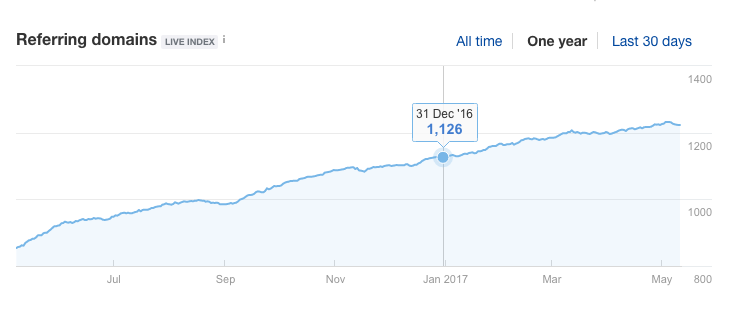

Similar to evergreen linking topics, they have the leverage of acquiring new visitors and potential customers from being able to rank for organic keywords. Given that they’ve been getting inbound links over time, they also have the tendency of improving its current search rankings - which can increase its lifetime link value.
For example, this page where I’ve acquired a backlink is getting consistent amount of links (see its link velocity graph).
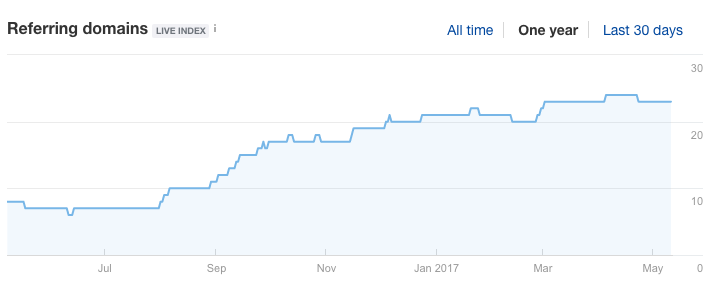




4. Temporal Links
Temporary links obtained through a “link renting” approach (similar to renting a house) have the lowest lifetime link value. Their value is predicated on the period of time the link remains sustained by the fees of the link buyer.
This type of links depreciates its link value, which can negatively affects the rankings of the content being linked to.
Imagine if a page is ranking within the top 3-5 spots for a target keyword and after a few months, 6 out of 10 of its temporal links have been removed by bloggers - this can certainly affects the page’s ranking.
While this hasn’t been proven by any study, the point in bringing this up is that temporal links can do more harm than good in the long run. Resources consumed for this type of links can be better off spent to links with high LTV.
4. Frequency of Updates
Determining the page’s frequency to updates or maintenance can help better assess its lifetime link value.
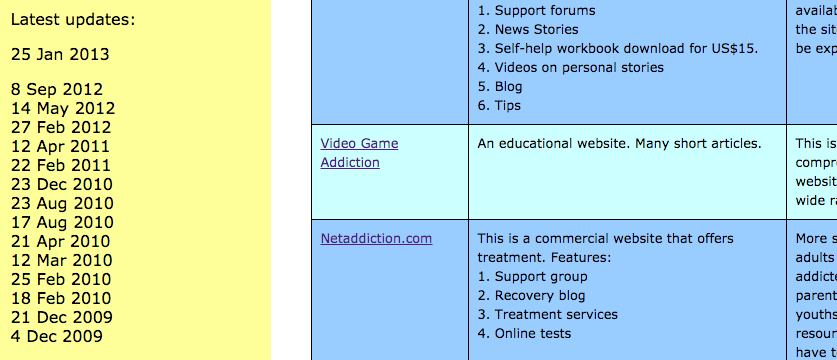

Static pages like resource pages with no updates since 2013 collects broken external links over time and is less likely being receptive to link request outreach pitches (some webmaster even planned to remove these pages).
Though these sites linking to 404s won’t be demoted by Google (as Gary Illyes answered Jennifer’s question), they are still perceived to provide a sub-optimal user experience. If you’re checking links on a resource page and find that most of them are broken, you wouldn’t take a chance to visit another link on the same page, even if it’s working in the first place.
No-longer-updated pages have low lifetime link value, as there are less likely to drive new visitors to their destination pages (their external links). Search engines won’t even try to rank these pages as they no longer updates information which are essential factor for search engines to decide which page deserve to rank for in search.
5. Link Neighbourhood
Checking the page’s link neighbourhood (other external links placed within the target page) is an imperative part of the link qualification process as it helps you better assess a backlink’s LTV.
A blog’s page with five commercial off-topic links is a low valued link neighborhood you certainly won’t get clicks from.
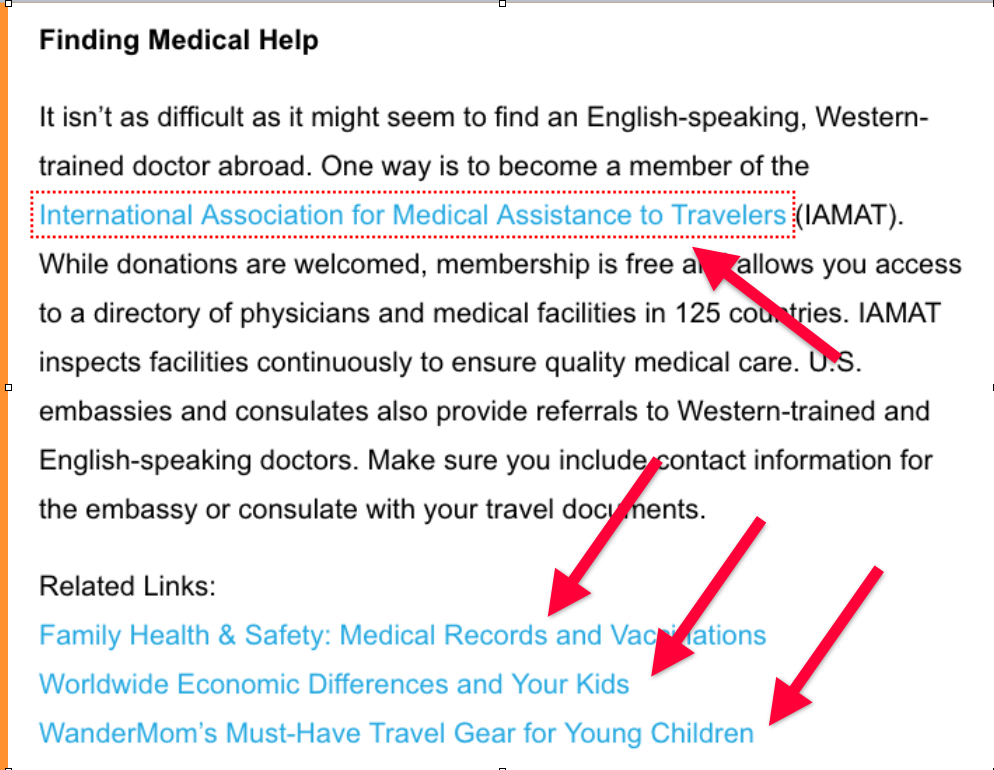

Check external links on the page and see if they’re mostly linking to commercial pages that aren’t thematically relevant to the content.
As a link building company, it has been part of our protocol not to acquire a link from a blog page with more than five external links and/or with a direct competitor link, unless the context of the page is a pure recommendation of services/products (i.e. top 25 productivity tools).
6. Indexability and Ranking Potentials
Indexability is fairly obvious, if a page isn’t indexed by search engines, it won’t certainly be found by target users. But there are potential link acquisition targets that are great opportunities on a naked eye view (well-designed and can potentially drive site traffic), but aren’t indexed by search engines in the first place.
To check if the site is actually indexed at the current time, you can use the command, site:domain.com and see if its pages are on search results (homepage should be at the #1 spot).
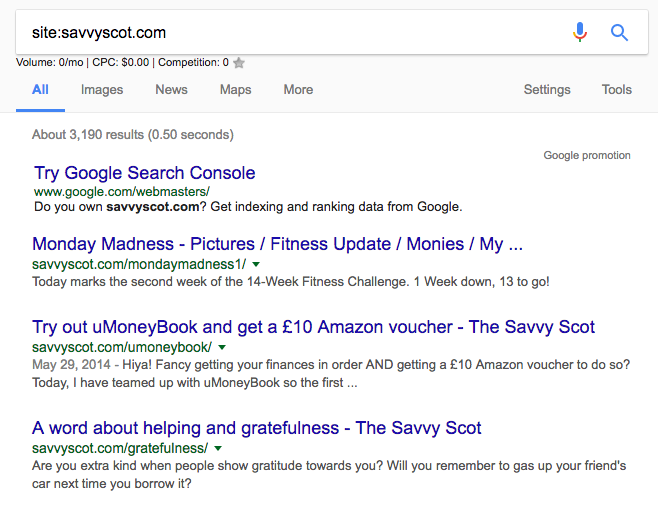

But more than that, target pages should at least rank in the first page for long-tail and/or low competitive keywords. The title tag of the homepage may not be worth assessing for in terms of rankings, as they may not be in the ranking positions yet. But going through its URL (target page), you should expect it to be visible in the first page of search results given that it’s targeting less competitive keyword than the homepage.
Ahrefs recently studied 3 million searches discovering the average number of keywords a page can rank for. They discovered that a page ranking for 10th, for example, can also rank for other 400~ related keywords.
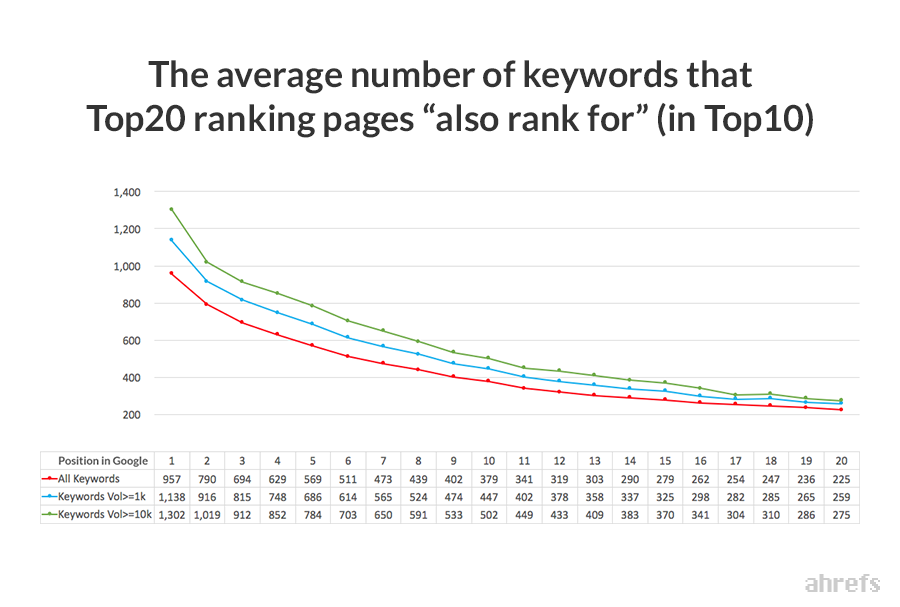

If you liked this post, you can follow me on Twitter @venchito14.

